Submitted:
30 November 2023
Posted:
01 December 2023
You are already at the latest version
Abstract
Keywords:
1. Introduction
2. Materials and Methods
2.1. Object and Approach
2.2. Instruments
2.3. Data Processing
3. Results
3.1. Variability and Diurnal Variation of n+
3.2. Variability and Diurnal Variation of n-
3.3. Variability and Diurnal Variation of ∇φ
3.4. Variability and Diurnal Variation of Jλ
4. Discussion
5. Conclusions
Author Contributions
Funding
Conflicts of Interest
Appendix A
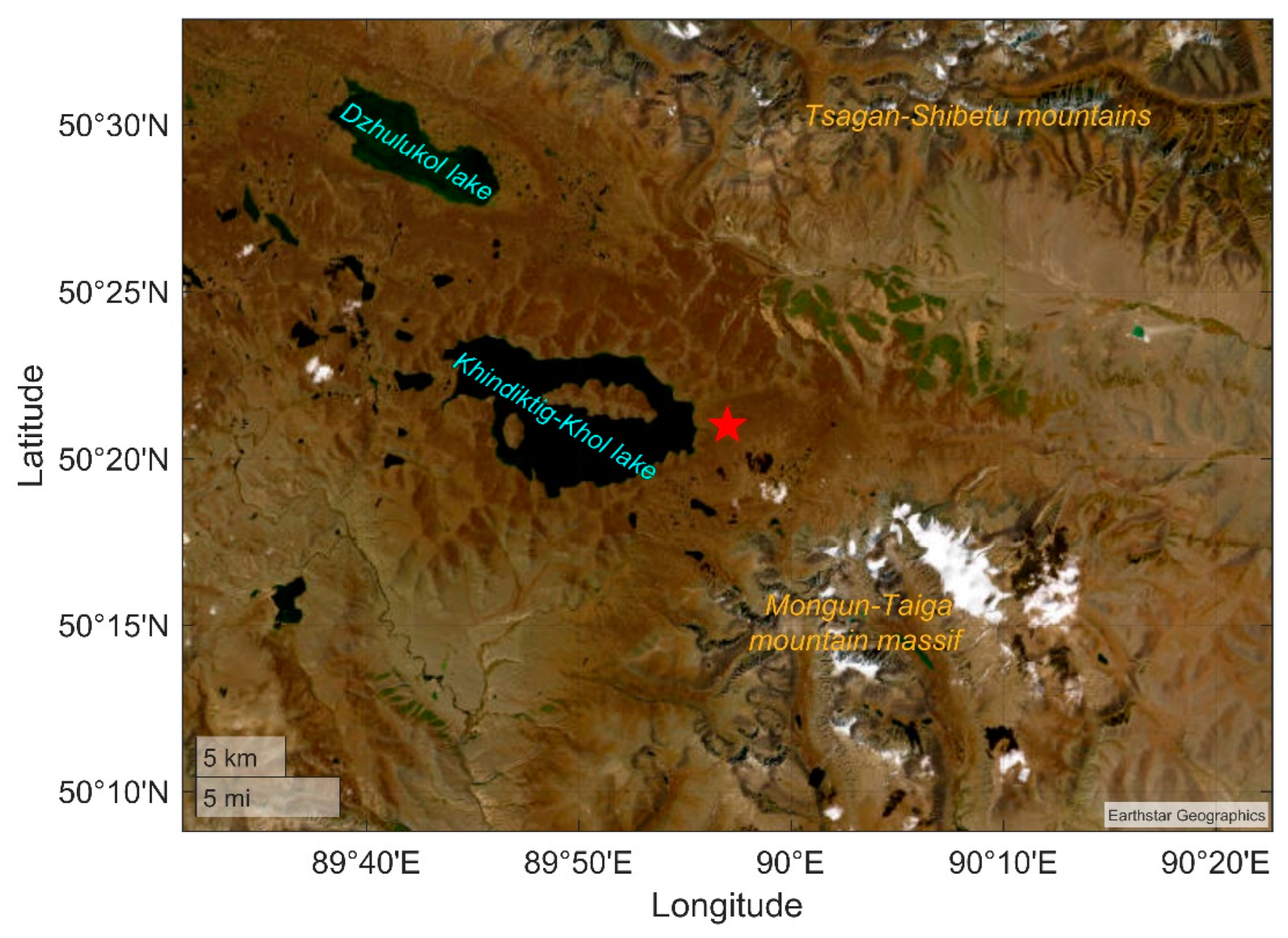
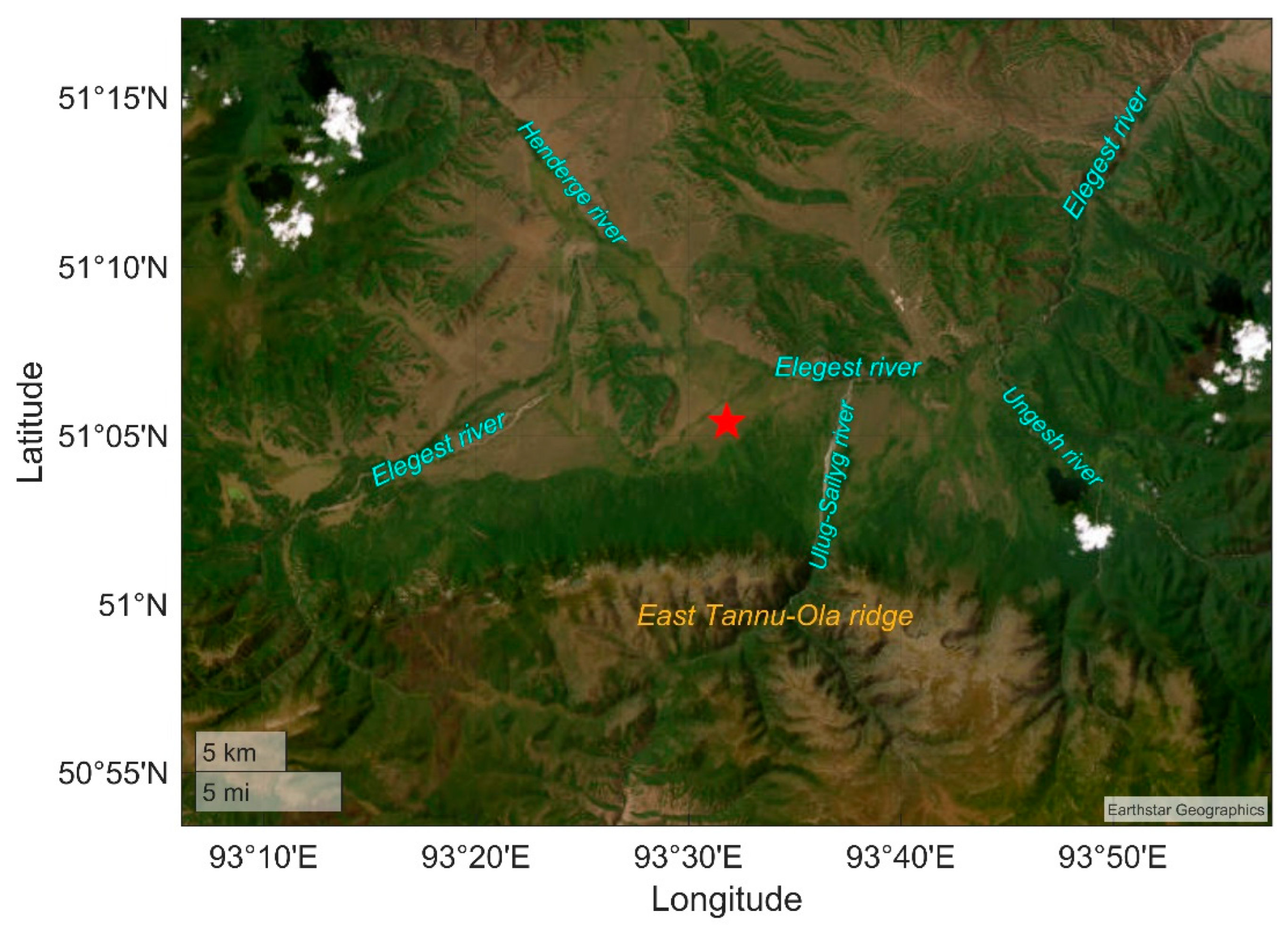
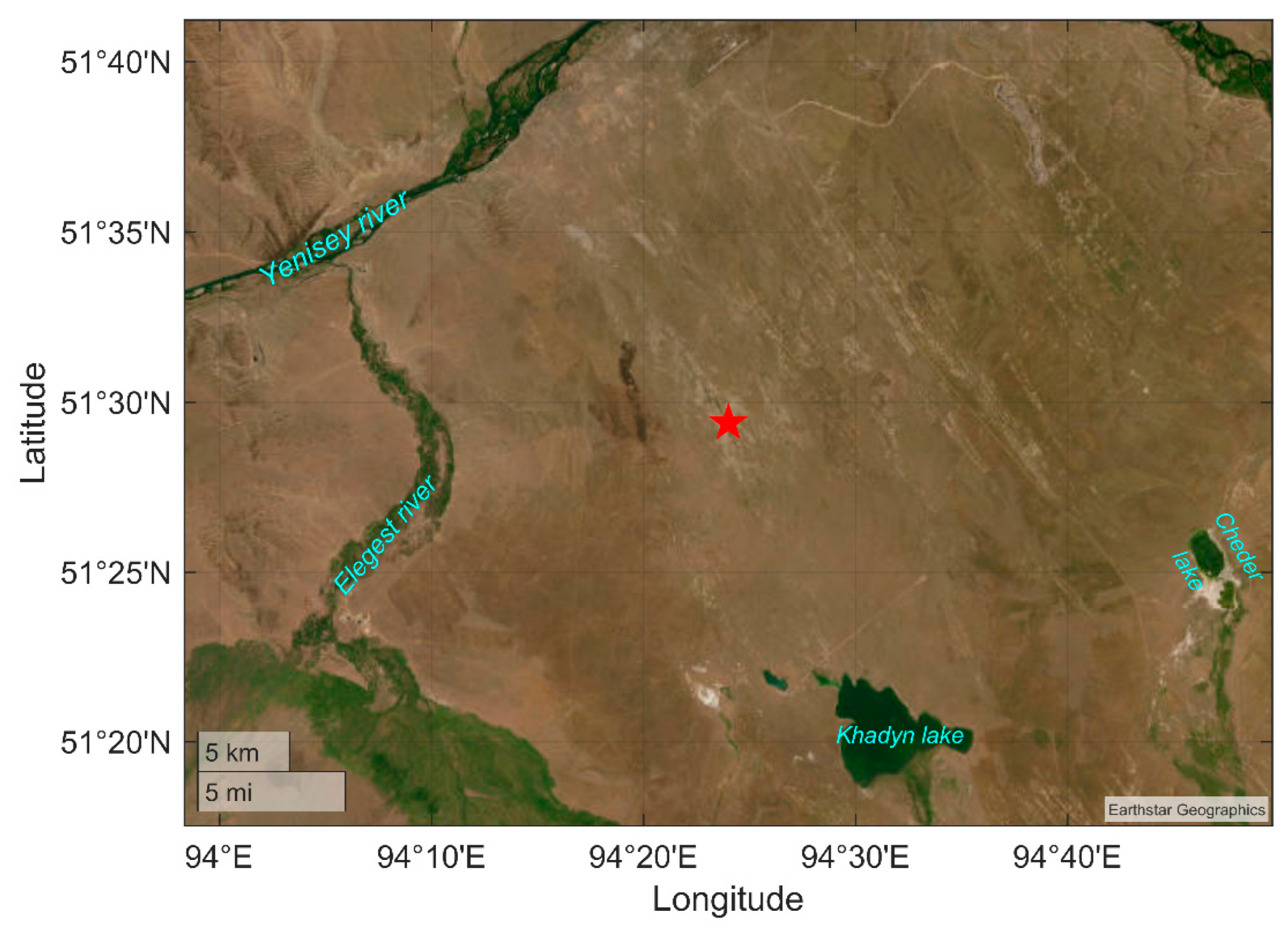
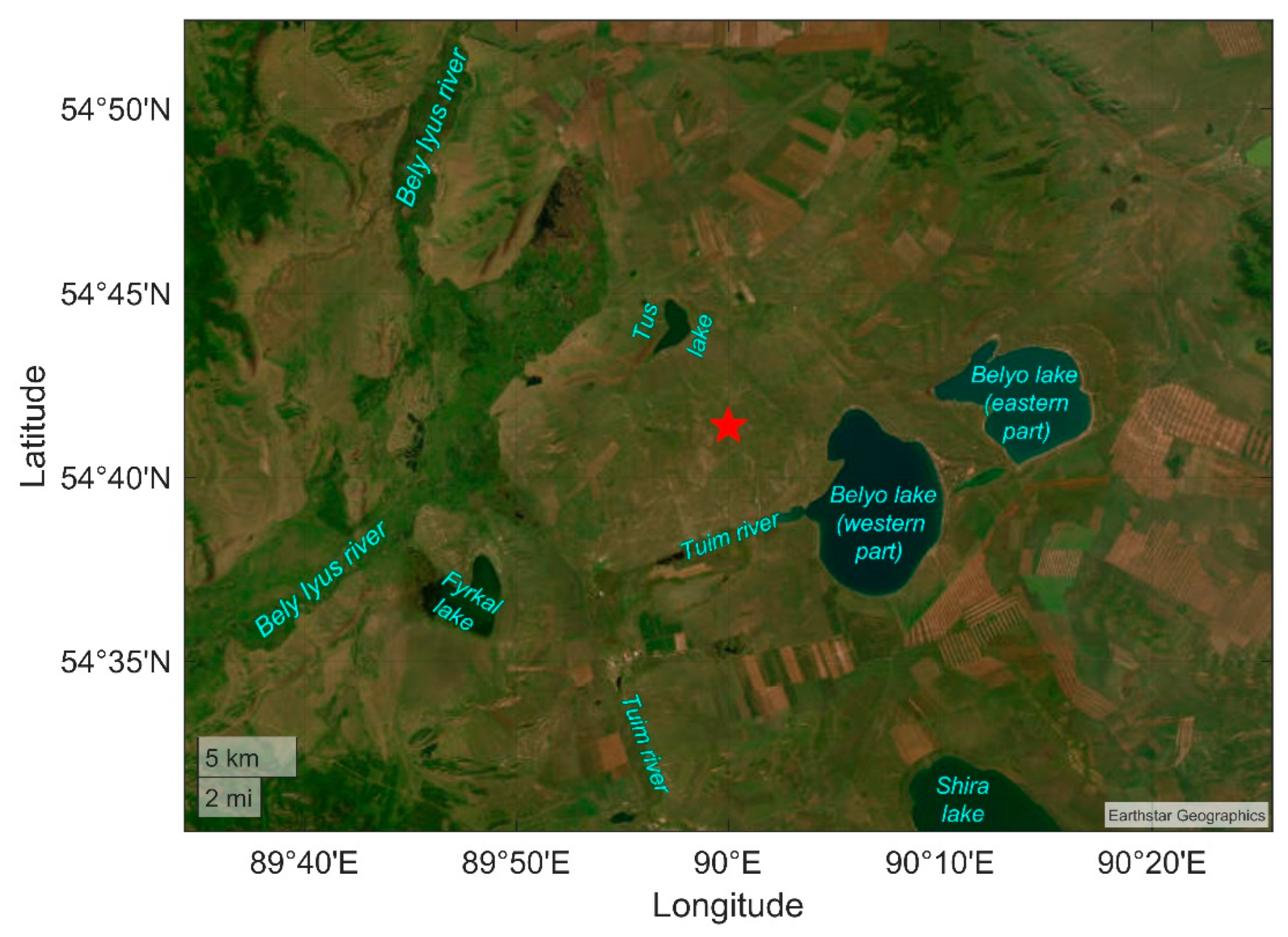

Appendix B
| Site | Mean, 103 cm–3 | Standard Deviation, 103 cm–3 | Median, 103 cm–3 | Interquartile Range, 103 cm–3 | 5th Percentile, 103 cm–3 | 25th Percentile, 103 cm–3 | 75th Percentile, 103 cm–3 | 95th Percentile, 103 cm–3 |
|---|---|---|---|---|---|---|---|---|
| 1 | 35 | 78 | 6.5 | 26 | 3.0 | 4.4 | 30 | 200 |
| 2 * | 3.6 | 0.8 | 3.7 | 1.2 | 2.3 | 3.0 | 4.2 | 5.0 |
| 3 | 23 | 66 | 3.7 | 5.6 | 1.4 | 2.7 | 8.4 | 110 |
| 4 | 180 | 430 | 25 | 47 | 1.7 | 4.3 | 51 | 1400 |
| Site | Mean, 103 cm–3 | Standard Deviation, 103 cm–3 | Median, 103 cm–3 | Interquartile Range, 103 cm–3 | 5th Percentile, 103 cm–3 | 25th Percentile, 103 cm–3 | 75th Percentile, 103 cm–3 | 95th Percentile, 103 cm–3 |
|---|---|---|---|---|---|---|---|---|
| 1 | 0.6 | 0.6 | 0.3 | 0.8 | 0.04 | 0.1 | 0.9 | 1.9 |
| 2 * | 1.2 | 0.6 | 1.0 | 0.7 | 0.6 | 0.8 | 1.5 | 2.5 |
| 3 | 1.4 | 0.5 | 1.2 | 1.3 | 0.3 | 0.7 | 2.0 | 3.1 |
| 4 | 1.0 | 0.9 | 0.7 | 0.9 | 0.2 | 0.4 | 1.3 | 3.1 |
| Site | Mean, V/m | Standard Deviation, V/m | Median, V/m | Interquartile Range, V/m | 5th Percentile, V/m | 25th Percentile, V/m | 75th Percentile, V/m | 95th Percentile, V/m |
|---|---|---|---|---|---|---|---|---|
| 1 | 120 | 31 | 110 | 33 | 77 | 96 | 130 | 160 |
| 2 | 75 | 38 | 69 | 26 | 42 | 57 | 83 | 120 |
| 3 | 92 | 28 | 89 | 29 | 52 | 76 | 110 | 140 |
| 4 | 77 | 48 | 68 | 38 | 25 | 51 | 89 | 150 |
| Site | Mean, 10−12 A/m2 | Standard Deviation, 10−12 A/m2 | Median, 10−12 A/m2 | Interquartile Range, 10−12 A/m2 | 5th Percentile, 10−12 A/m2 | 25th Percentile, 10−12 A/m2 | 75th Percentile, 10−12 A/m2 | 95th Percentile, 10−12 A/m2 |
|---|---|---|---|---|---|---|---|---|
| 1 | 70 | 80 | 40 | 120 | 10 | 12 | 130 | 230 |
| 2 * | − | − | − | − | − | − | − | − |
| 3 | 43 | 63 | 11 | 38 | 7 | 8 | 46 | 190 |
| 4 | 350 | 680 | 30 | 360 | 8 | 14 | 380 | 2100 |
Appendix C
| Predictor | Site 1 | Site 2 * | Site 3 | Site 4 |
|---|---|---|---|---|
| Site 1 | – | Y = –7.90·10–2·X + 4.31·103 R2 = 0.41 |
Y = 3.81·10–1·X + 1.31·104 R2 = 0.13 |
Y = 1.43·X + 1.55·105 R2 = 0.02 |
| Site 2 * | Y = –5.22·X + 2.75·104 R2 = 0.41 |
– | Y = –2.62·10–1·X + 4.12·103 R2 = 0.23 |
Y = –9.42·X + 6.46·104 R2 = 0.17 |
| Site 3 | Y = 3.46·10–1·X + 2.62·104 R2 = 0.13 |
Y = –8.66·10–1·X + 6.38·103 R2 = 0.23 |
– | Y = 6.76·X + 2.59·104 R2 = 0.59 |
| Site 4 | Y = 1.69·10–2·X + 3.2·104 R2 = 0.02 |
Y = –1.79·10–2·X + 4.17·103 R2 = 0.17 |
Y = 8.76·10–1·X + 8.57·103 R2 = 0.59 |
– |
| Predictor | Site 1 | Site 2 * | Site 3 | Site 4 |
|---|---|---|---|---|
| Site 1 | – | Y = –2.44·10–1·X + 1.15·103 R2 = 0.02 |
Y = 2.96·10–1·X + 1.28·103 R2 = 0.12 |
Y = –2.46·10–1·X + 1.11·103 R2 = 0.09 |
| Site 2 * | Y = –8.63·10–2·X + 2.71·102 R2 = 0.02 |
– | Y = –2.66·10–1·X + 1.82·103 R2 = 0.05 |
Y = 2.56·10–1·X + 9.35·102 R2 = 0.04 |
| Site 3 | Y = 4.12·10–1·X + 1.31·101 R2 = 0.12 |
Y = –1.97·10–1·X + 1.41·103 R2 = 0.05 |
– | Y = 3.25·10–1·X + 4.82·102 R2 = 0.11 |
| Site 4 | Y = –3.55·10–1·X + 9.56·102 R2 = 0.09 |
Y = 1.36·10–1·X + 9.40·102 R2 = 0.04 |
Y = 3.38·10–1·X + 1.14·103 R2 = 0.11 |
– |
| Predictor | Site 1 | Site 2 | Site 3 | Site 4 |
|---|---|---|---|---|
| Site 1 | – | Y = 2.58·10–1·X + 4.51·101 R2 = 0.04 |
Y = 8.36·10–1·X – 4.27·100 R2 = 0.51 |
Y = –1.56·10–1·X + 9.53·101 R2 = 0.01 |
| Site 2 | Y = 1.72·10–1·X + 1.02·102 R2 = 0.04 |
– | Y = 4.79·10–1·X + 5.61·101 R2 = 0.25 |
Y = 7.51·10–1·X + 2.12·101 R2 = 0.23 |
| Site 3 | Y = 6.07·10–1·X + 5.93·101 R2 = 0.51 |
Y = 5.21·10–1·X + 2.69·101 R2 = 0.25 |
– | Y = 5.98·10–1·X + 2.24·101 R2 = 0.13 |
| Site 4 | Y = –4.22·10–2·X + 1.18·102 R2 = 0.01 |
Y = 3.04·10–1·X + 5.13·101 R2 = 0.23 |
Y = 2.22·10–1·X + 7.47·101 R2 = 0.13 |
– |
| Time (UTC/LT) | Site 1 | Site 2 | Site 3 | Site 4 | ||||
|---|---|---|---|---|---|---|---|---|
| V/m | % of mean | V/m | % of mean | V/m | % of mean | V/m | % of mean | |
| 00/07 | 94 | 82 | 100 | 133 | 88 | 96 | 153 | 199 |
| 01/08 | 108 | 94 | 80 | 107 | 98 | 107 | 132 | 171 |
| 02/09 | 117 | 102 | 72 | 96 | 113 | 123 | 100 | 130 |
| 03/10 | 111 | 97 | 73 | 97 | 106 | 115 | 83 | 108 |
| 04/10 | 121 | 105 | 85 | 113 | 105 | 114 | 76 | 99 |
| 05/11 | 117 | 102 | 93 | 124 | 105 | 114 | 89 | 116 |
| 06/12 | 120 | 104 | 113 | 151 | 110 | 120 | 93 | 121 |
| 07/13 | 122 | 106 | 80 | 107 | 104 | 113 | 107 | 139 |
| 08/14 | 130 | 113 | 76 | 101 | 108 | 117 | 78 | 101 |
| 09/15 | 138 | 120 | 86 | 115 | 105 | 114 | 78 | 101 |
| 10/17 | 141 | 123 | 76 | 101 | 113 | 123 | 65 | 84 |
| 11/18 | 133 | 116 | 70 | 93 | 106 | 115 | 65 | 84 |
| 12/19 | 124 | 108 | 63 | 84 | 90 | 98 | 52 | 68 |
| 13/20 | 115 | 100 | 108 | 144 | 86 | 93 | 49 | 64 |
| 14/21 | 115 | 100 | 63 | 84 | 89 | 97 | 47 | 61 |
| 15/22 | 112 | 97 | 61 | 81 | 86 | 93 | 50 | 65 |
| 16/23 | 94 | 82 | 62 | 83 | 64 | 70 | 55 | 71 |
| 17/00 | 85 | 74 | 55 | 73 | 66 | 72 | 48 | 62 |
| 18/01 | 102 | 89 | 54 | 72 | 70 | 76 | 66 | 86 |
| 19/02 | 102 | 89 | 60 | 80 | 77 | 84 | 67 | 87 |
| 20/03 | 115 | 100 | 65 | 87 | 93 | 101 | 80 | 104 |
| 21/04 | 122 | 106 | 58 | 77 | 82 | 89 | 82 | 106 |
| 22/05 | 114 | 99 | 55 | 73 | 69 | 75 | 62 | 81 |
| 23/06 | 108 | 94 | 83 | 111 | 71 | 77 | 79 | 103 |
Appendix D
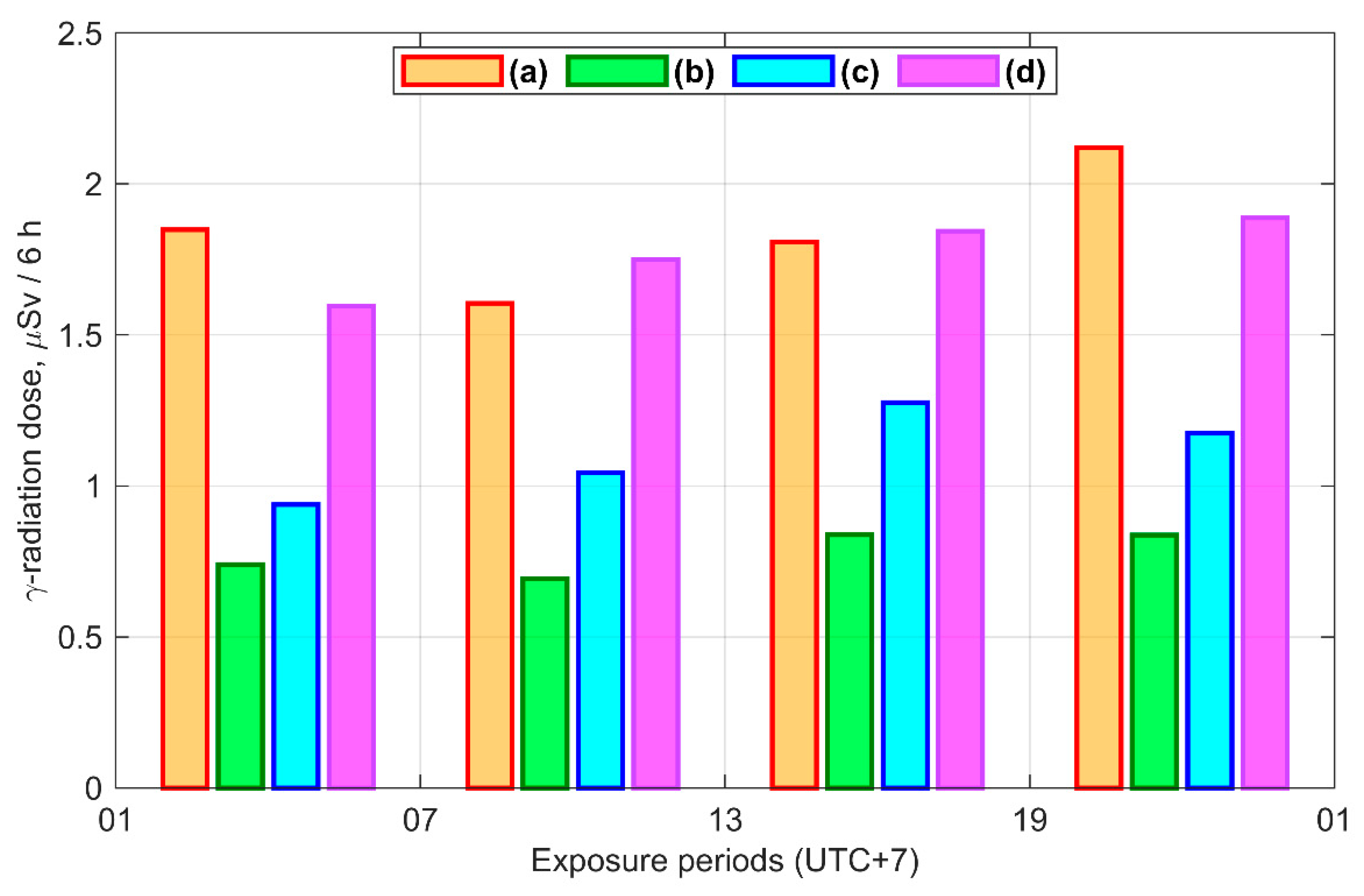
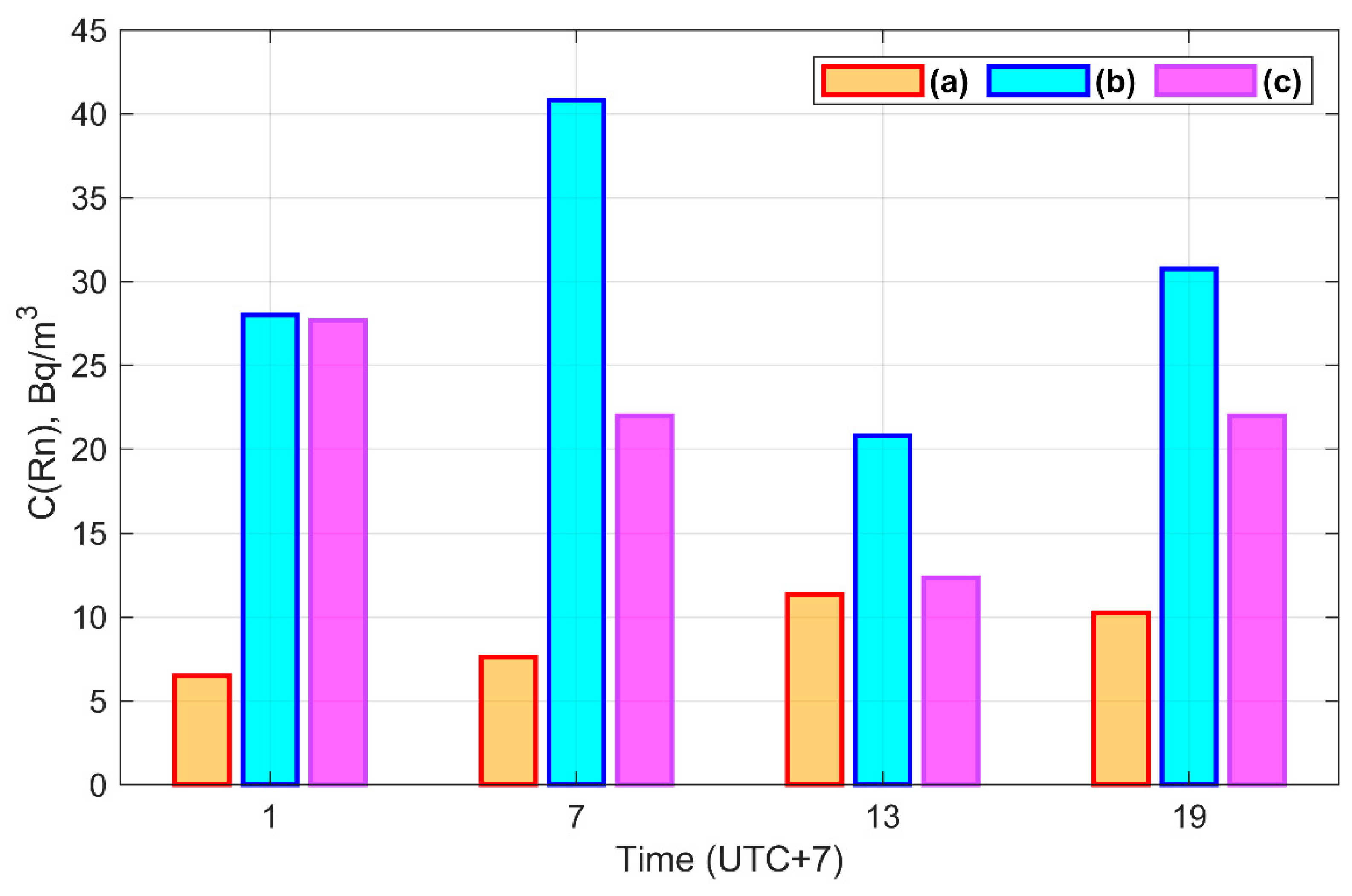
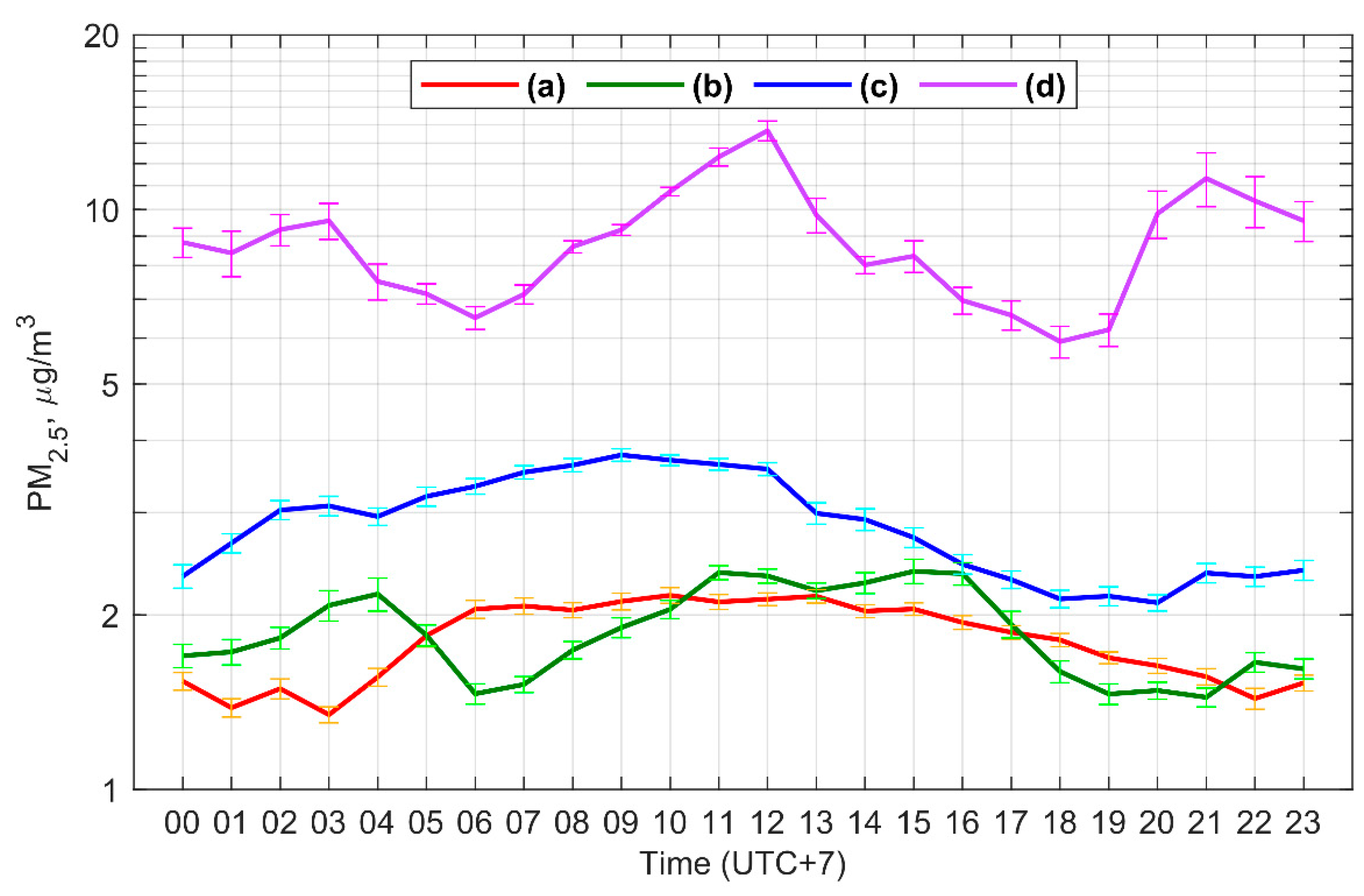
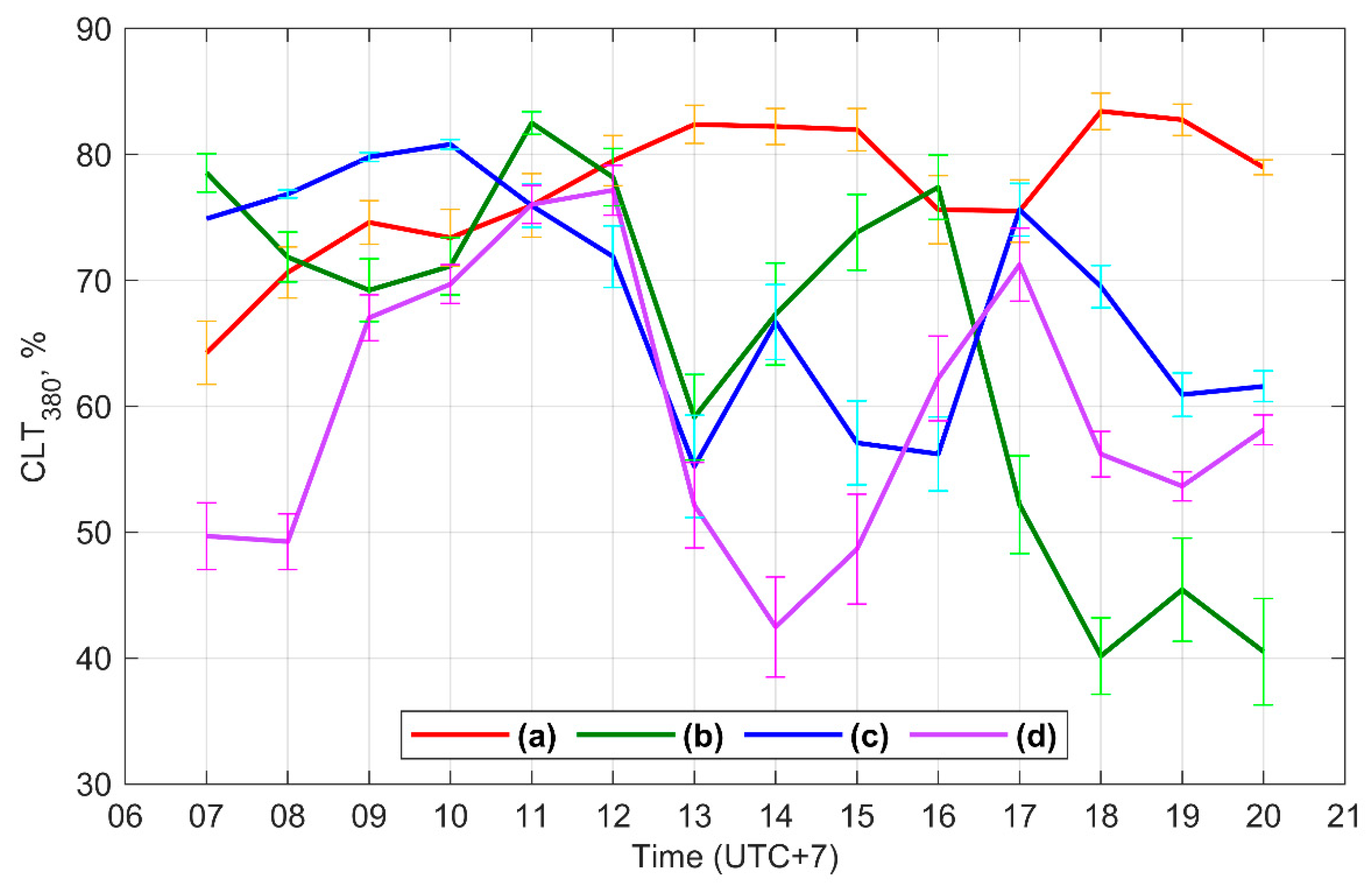
Appendix E
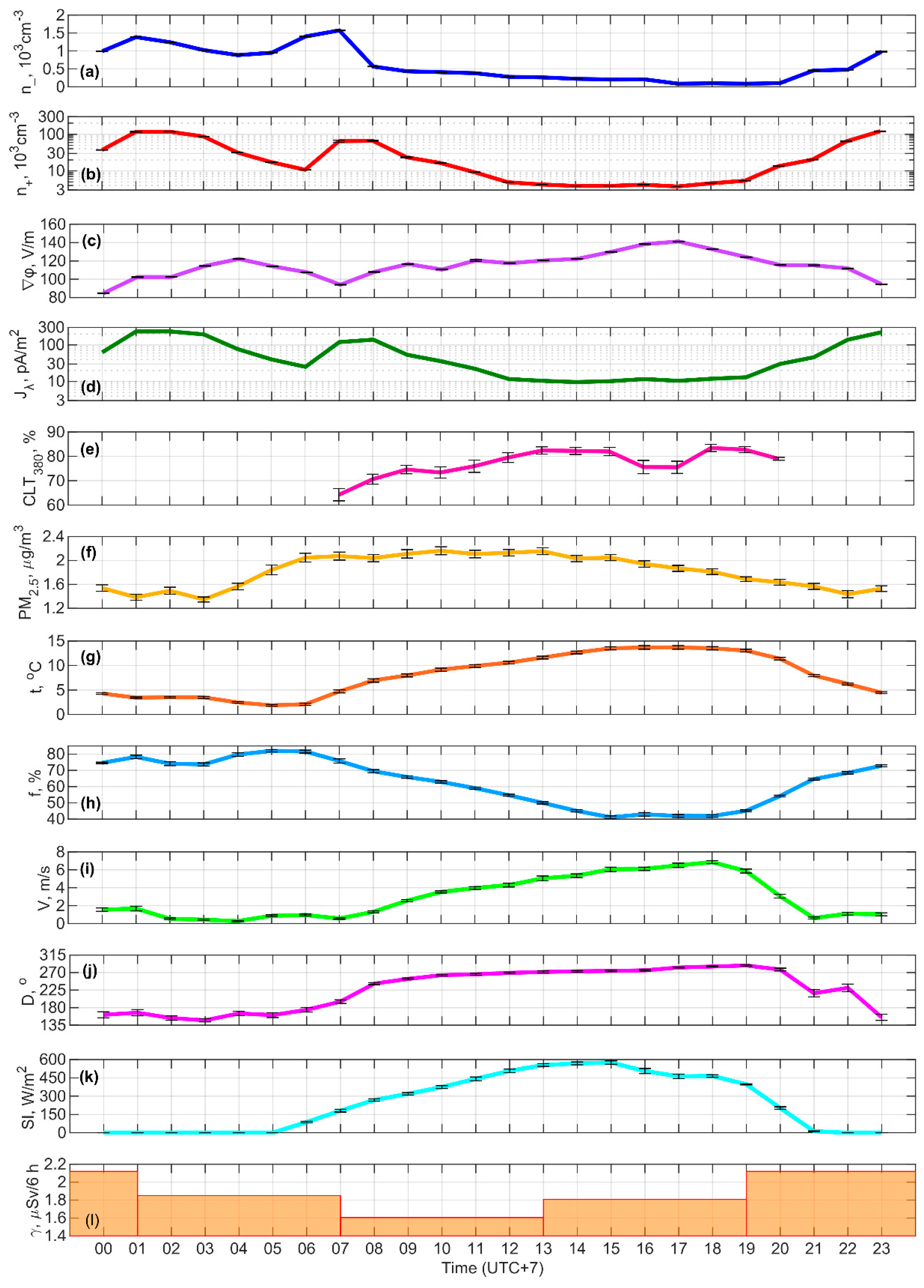
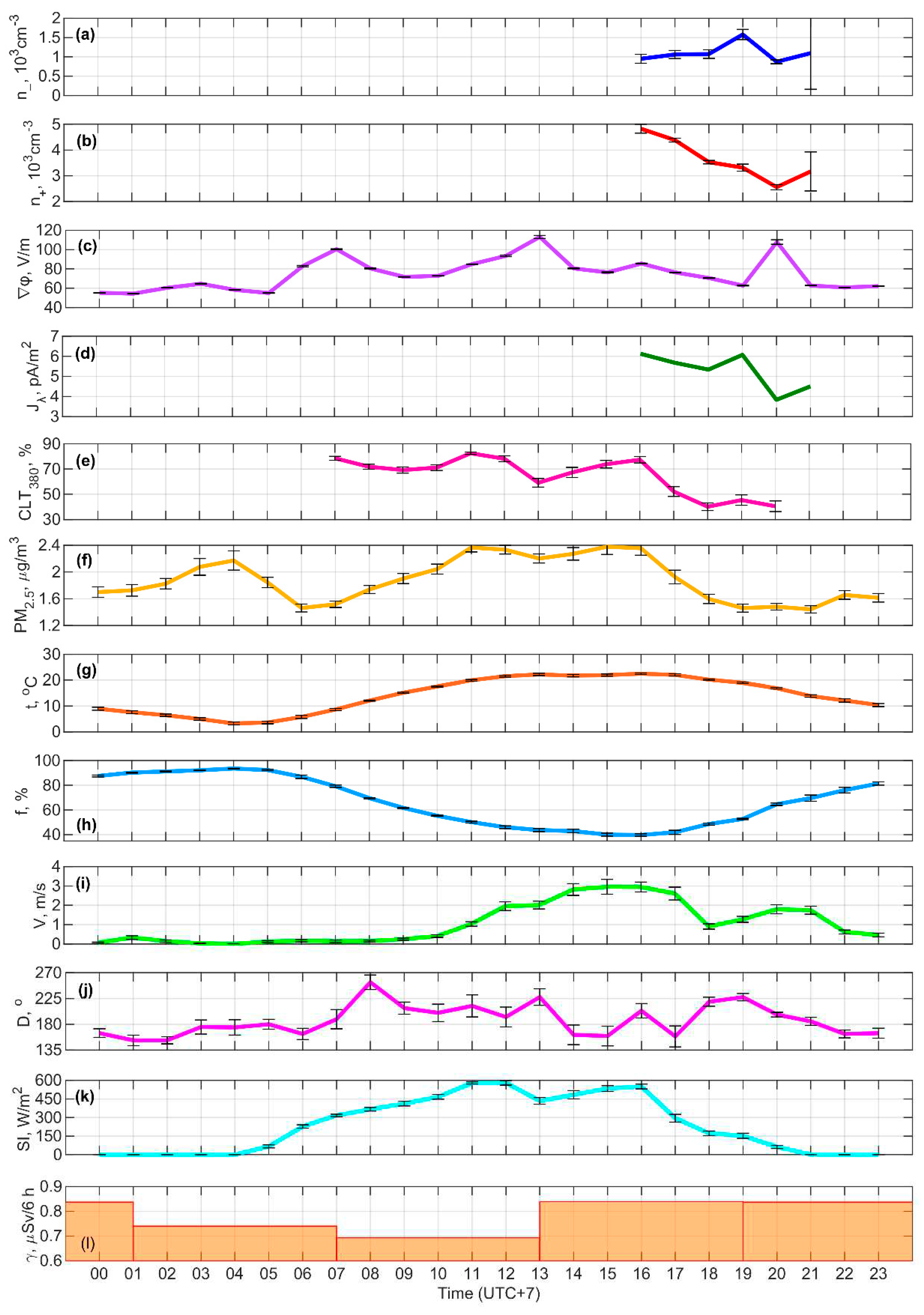
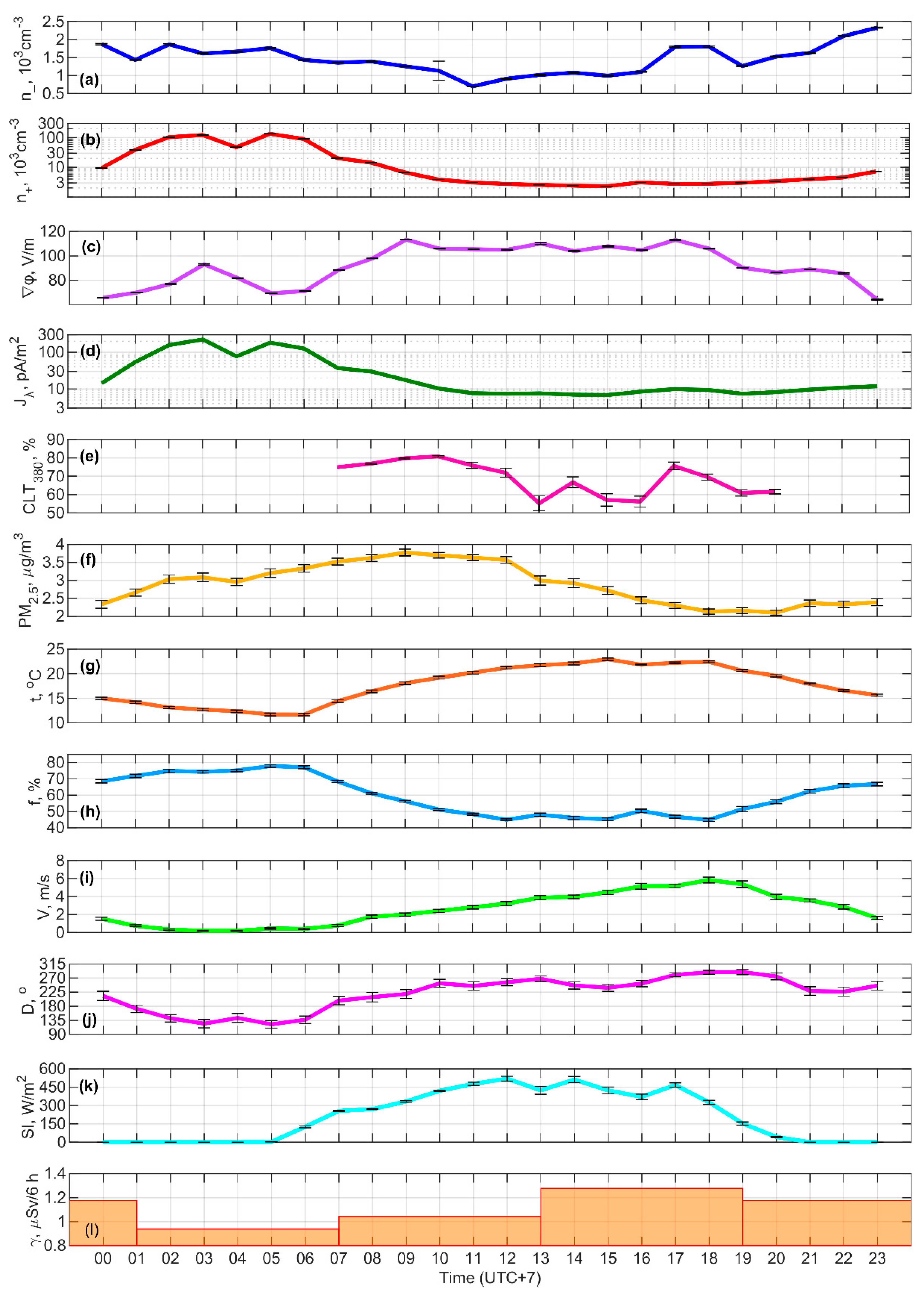
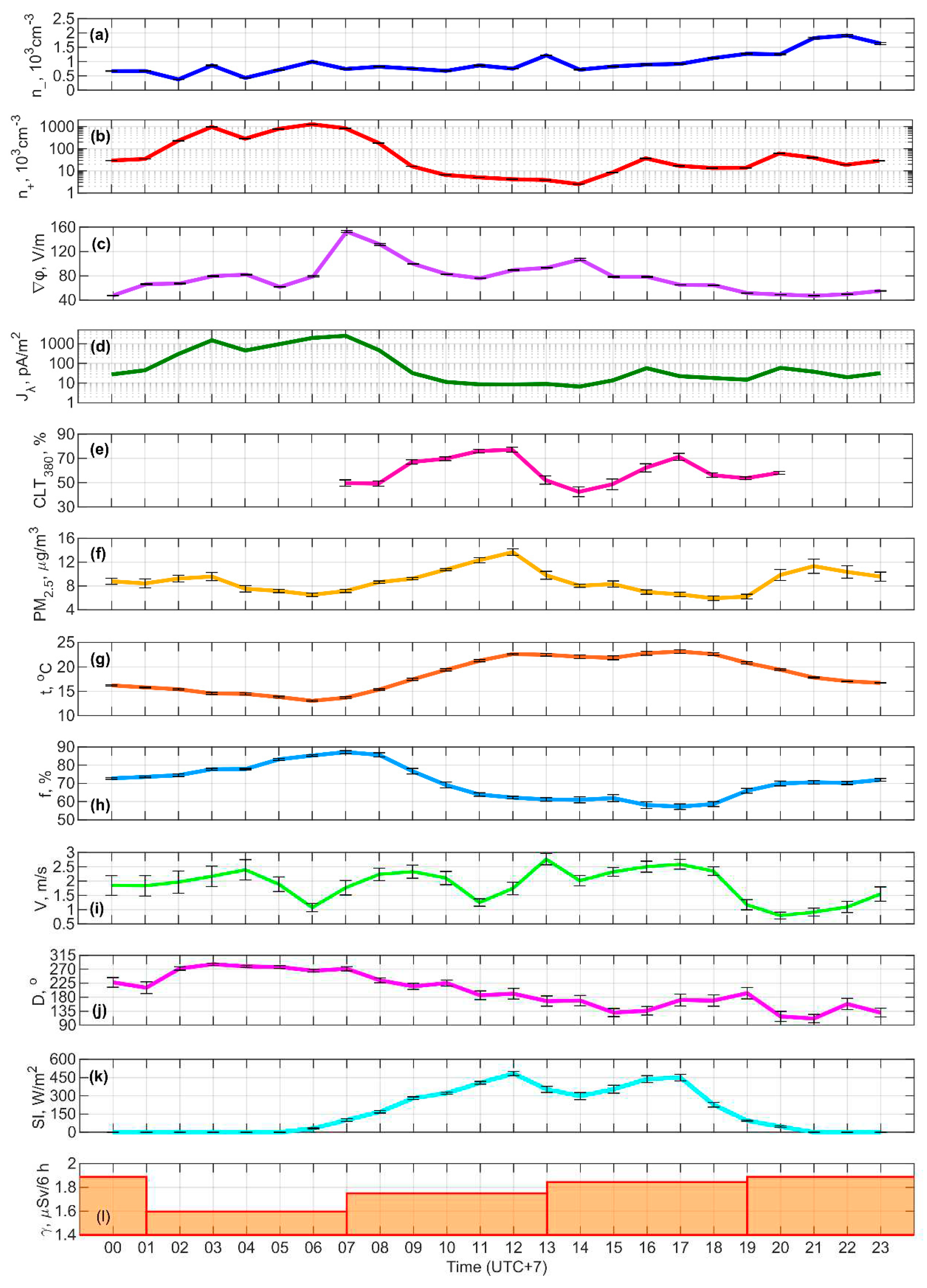
Appendix F
| Predictor | n+, cm-3 | n–, cm-3 | ∇φ, V/m |
|---|---|---|---|
| n+, cm-3 | – | Y = 8.15·10–3·X + 3.27·102 R2 = 0.47 |
Y = – 2.21·10–1·X + 1.23·102 R2 = 0.42 |
| n–, cm-3 | Y = 5.75·101·X + 2.06·101 R2 = 0.47 |
– | Y = –2.14·10–2·X + 1.28·102 R2 = 0.56 |
| ∇φ, V/m | Y = –1.89·103·X + 2.53·105 R2 = 0.42 |
Y = –2.59·101·X + 3.6·103 R2 = 0.56 |
– |
| CLT380, % | Y = –3.24·103·X + 2.66·105 R2 = 0.68 |
Y = –5.74·101·X + 4.78·103 R2 = 0.68 |
Y = 1.39·X + 1.36·101 R2 = 0.38 |
| PM2.5, µg/m3 | Y = –8.87·104·X + 1.96·105 R2 = 0.39 |
Y = –5.61·102·X + 1.63·103 R2 = 0.11 |
Y = 1.44·101·X + 8.88·101 R2 = 0.09 |
| t, °C | Y = –6.07·103·X + 8.41·104 R2 = 0.42 |
Y = –1.00·102·X + 1.42·103 R2 = 0.80 |
Y = 2.34·X + 9.63·101 R2 = 0.53 |
| f, % | Y = 1.73·103·X – 7.24·104 R2 = 0.38 |
Y = 2.90·101·X – 1.2·103 R2 = 0.76 |
Y = –7.24·10–1·X + 1.60·102 R2 = 0.58 |
| V, m/s | Y = –1.13·104·X + 6.85·104 R2 = 0.43 |
Y = –1.63·102·X + 1.09·103 R2 = 0.63 |
Y = 4.42·X + 1.02·102 R2 = 0.56 |
| D, ° | Y = –5.38·102·X + 1.58·105 R2 = 0.51 |
Y = –8.03·X + 2.44·103 R2 = 0.80 |
Y = 1.79·10–1·X + 7.45·101 R2 = 0.48 |
| SI, W/m2 | Y = –1.19·102·X + 6.47·104 R2 = 0.46 |
Y = –1.53·X + 9.94·102 R2 = 0.55 |
Y = 3.99·10–2·X + 1.05·102 R2 = 0.45 |
| Predictor | n+, cm-3* | n–, cm-3* | ∇φ, V/m |
|---|---|---|---|
| n+, cm-3* | – | – | – |
| n–, cm-3* | – | – | – |
| ∇φ, V/m | – | – | – |
| CLT380, % | – | – | Y = 9.22·10–2·X + 7.81·101 R2 = 0.01 |
| PM2.5, µg/m3 | – | – | Y = 1.08·101·X + 5.45·101 R2 = 0.05 |
| t, °C | – | – | Y = 1.29·X + 5.66·101 R2 = 0.27 |
| f, % | – | – | Y = –4.46·10–1·X + 1.04·102 R2 = 0.28 |
| V, m/s | – | – | Y = 7.15·X + 6.73·101 R2 = 0.20 |
| D, ° | – | – | Y = 2.55·10–1·X + 2.71·101 R2 = 0.18 |
| SI, W/m2 | – | – | Y = 4.50·10–1·X + 6.40·101 R2 = 0.36 |
| Predictor | n+, cm-3 | n–, cm-3 | ∇φ, V/m |
|---|---|---|---|
| n+, cm-3 | – | Y = 2.75·10–3·X + 1.39·103 R2 = 0.08 |
Y = –1.90·10–4·X + 9.69·101 R2 = 0.25 |
| n–, cm-3 | Y = 2.97·101·X – 1.69·104 R2 = 0.08 |
– | Y = –2.49·10–2·X + 1.28·102 R2 = 0.39 |
| ∇φ, V/m | Y = –1.30·103·X + 1.46·105 R2 = 0.25 |
Y = –1.58·101·X + 2.91·103 R2 = 0.39 |
– |
| CLT380, % | Y = 2.07·103·X – 9.92·104 R2 = 0.15 |
Y = 1.84·101·X + 1.26·102 R2 = 0.22 |
Y = –7.54·10–1·X + 1.41·102 R2 = 0.16 |
| PM2.5, µg/m3 | Y = 1.79·104·X –2.52·104 R2 = 0.06 |
Y = –3.59·102·X + 2.5·103 R2 = 0.25 |
Y = 6.53·X + 7.30·101 R2 = 0.05 |
| t, °C | Y = –8.33·103·X + 1.74·105 R2 = 0.59 |
Y = –5.16·101·X + 2.38·103 R2 = 0.24 |
Y = 3.27·X + 3.41·101 R2 = 0.62 |
| f, % | Y = 2.66·103·X – 1.32·105 R2 = 0.57 |
Y = 1.93·101·X + 3.14·102 R2 = 0.32 |
Y = –1.12·X + 1.59·101 R2 = 0.69 |
| V, m/s | Y = –1.58·104·X + 6.78·104 R2 = 0.48 |
Y = –6.06·103·X + 1.62·103 R2 = 0.08 |
Y = 5.49·X + 7.76·101 R2 = 0.40 |
| D, ° | Y = –6.91·102·X + 1.78·105 R2 = 0.78 |
Y = –1.96·X + 1.89·103 R2 = 0.07 |
Y = 1.72·10–1·X + 5.41·101 R2 = 0.33 |
| SI, W/m2 | Y = –1.06·102·X + 4.92·104 R2 = 0.27 |
Y = –1.44·X + 1.77·103 R2 = 0.53 |
Y = 6.68·10–2·X + 7.76·101 R2 = 0.73 |
| Predictor | n+, cm-3 | n–, cm-3 | ∇φ, V/m |
|---|---|---|---|
| n+, cm-3 | – | Y = –2.10·10–4·X + 1.00·103 R2 = 0.04 |
Y = 1.94·10–5·X + 7.33·101 R2 = 0.07 |
| n–, cm-3 | Y = –1.82·102·X + 3.8·105 R2 = 0.04 |
– | Y = –2.86·10–2·X + 1.05·102 R2 = 0.19 |
| ∇φ, V/m | Y = 3.81·103·X – 8.87·104 R2 = 0.07 |
Y = –6.46·X + 1.46·103 R2 = 0.19 |
– |
| CLT380, % | Y = 2.32·103·X + 1.97·105 R2 = 0.00 |
Y = –6.46·X + 1.14·103 R2 = 0.12 |
Y = –1.07·X + 1.50·102 R2 = 0.19 |
| PM2.5, µg/m3 | Y = –5.89×104·X + 7.25×105 R2 = 0.10 |
Y = 3.50×101·X + 6.49×102 R2 = 0.03 |
Y = –9.71×10–1·X + 8.59×101 R2 = 0.01 |
| t, °C | Y = –7.36·104·X + 1.55·106 R2 = 0.48 |
Y = 1.78·101·X + 6.31·102 R2 = 0.02 |
Y = –9.71·10–1·X + 9.51·101 R2 = 0.02 |
| f, % | Y = 2.83·104·X – 1.79·106 R2 = 0.50 |
Y = –8.18·X + 1.54·103 R2 = 0.04 |
Y = 9.50·10–1·X + 1.02·101 R2 = 0.11 |
| V, m/s | Y = –8.28·104·X + 3.6·105 R2 = 0.02 |
Y = –3.66·102·X + 1.64·103 R2 = 0.27 |
Y = 1.85·101·X + 4.28·101 R2 = 0.16 |
| D, ° | Y = 4.50·103·X – 6.94·105 R2 = 0.47 |
Y = –4.61·X + 1.88·103 R2 = 0.43 |
Y = 1.75·10–1·X + 4.23·101 R2 = 0.14 |
| SI, W/m2 | Y = –8.62·102·X + 3.51·105 R2 = 0.18 |
Y = –4.19·10–1·X + 1.03·103 R2 = 0.04 |
Y = 4.55·10–2·X + 6.96·101 R2 = 0.10 |
References
- Harrison, R.G. The Carnegie Curve. Surv. Geophys. 2013, 34, 209–232. [Google Scholar] [CrossRef]
- Nicoll, K.A.; Harrison, R.G.; Barta, V.; et al. A global atmospheric electricity monitoring network for climate and geophysical research. J. Atmos. Terr. Phys. 2019, 184, 18–29. [Google Scholar] [CrossRef]
- Anisimov, S.V.; Afinogenov, K.V.; Shikhova, N. Dynamics of undisturbed midlatitude atmospheric electricity: From observations to scaling. Radiophys. Quantum Electron. 2014, 56, 709–722. [Google Scholar] [CrossRef]
- Toropov, A.A.; Kozlov, V.I.; Karimov, R.R. Variations of the Atmospheric Electric Field by Observations in Yakutsk. Arct. Subarct. Nat. Resour. 2016, 2, 58–65. (In Russian) [Google Scholar]
- Smirnov, S. Annual variation of atmospheric electricity diurnal variation maximum in Kamchatka. EPJ Web Conf. 2021, 254, 01001. [Google Scholar] [CrossRef]
- Yaniv, R.; Yair, Y.; Price, C.; Katz, S. Local and global impacts on the fair-weather electric field in Israel. Atmos. Res. 2016, 172–173, 119–125. [Google Scholar] [CrossRef]
- Smirnov, S.E. Influence of a convective generator on the diurnal behavior of the electric field strength in the near-earth atmosphere in Kamchatka. Geomagn. Aeron. 2013, 53, 515–521. [Google Scholar] [CrossRef]
- Lopes, F.; Silva, H.G.; Bennett, A.J.; Reis, A.H. Global Electric Circuit research at Graciosa Island (ENA-ARM facility): First year of measurements and ENSO influences. J. Electrost. 2017, 87, 203–211. [Google Scholar] [CrossRef]
- Silva, H.G.; Conceição, R.; Melgão, M.; Nicoll, K.; Mendes, P.B.; Tlemçani, M.; Reis, A.H.; Harrison, R.G. Atmospheric electric field measurements in urban environment and the pollutant aerosol weekly dependence. Environ. Res. Lett. 2014, 9, 114025. [Google Scholar] [CrossRef]
- Bennett, A.J.; Harrison, R.G. Variability in surface atmospheric electric field measurements. J.Phys.Conf. Ser. 2008, 142, 012046. [Google Scholar] [CrossRef]
- Bennett, A.J.; Harrison, R.G. Atmospheric electricity in different weather conditions. Weather 2007, 62, 277–283. [Google Scholar] [CrossRef]
- Нoрреl, W.A. Theory of the electrode effect. J. Atmos. Terr. Phys. 1967, 29, 708–721. [Google Scholar]
- Israël, H. Atmospheric Electricity: Atmosphèarische Elektrizitèat; National Technical Information Service; US Department of Commerce: Springfield, VA, USA, 1970; 796 p. Atmospheric Electricity. Vol 2: Fields, charges, currents; Israel Program for Scientific Translations: Jerusalem, Israel, 1973; 365 p.
- Hoppel, W.A.; Frick, G.M. Ion-aerosol attachment coefficients and the steady state charge distribution on aerosols in a bipolar ion environment. Aerosol Sci. Technol. 1986, 5, 1–21. [Google Scholar] [CrossRef]
- Kupovykh, G.V.; Morozov, V.N.; Shvarts, Y.M. Theory of the Electrode Effect in the Atmosphere; TSURE Publishing: Taganrog, Russia, 1998. 124 p. (In Russian) [Google Scholar]
- Petrov, A.I.; Petrova, G.G.; Panchishkina, I.N. Profiles of polar conductivities and radon-222 concentration in the atmosphere by stable and labile stratification of surface layer. Atmos. Res. 2009, 91, 206–214. [Google Scholar] [CrossRef]
- Morozov, V.N.; Kupovich, G.V. Theory of Electrical Phenomena in Atmosphere; Lap Lambert Academic Publishing: Saarbruken, Germany, 2012; 330 p. [Google Scholar]
- Anisimov, S.V.; Galichenko, S.V.; Shikhova, N.M.; Afinogenov, K.V. Electricity of the convective atmospheric boundary layer: Field observations and numerical simulation. Izv. Atmos. Ocean. Phys. 2014, 50, 390–398. [Google Scholar] [CrossRef]
- Adzhiev, A.K.; Kupovykh, G.V. Measurements of the Atmospheric Electric Field under High-Mountain Conditions in the Vicinity of Mt. Elbrus. Izv. Atmos. Ocean. Phys. 2015, 51, 633–638. [Google Scholar] [CrossRef]
- Anisimov, S.V.; Galichenko, S.V.; Mareev, E.A. Electrodynamic properties and height of atmospheric convective boundary layer. Atmos. Res. 2017, 194, 119–129. [Google Scholar] [CrossRef]
- Pustovalov, K.; Nagorskiy, P.; Oglezneva, M.; Smirnov, S. The Electric Field of the Undisturbed Atmosphere in the South of Western Siberia: A Case Study on Tomsk. Atmosphere. 2022, 13(4), 614. [Google Scholar] [CrossRef]
- Li, L.; Chen, T.; Ti, Sh.; Wang, Sh.; ·Cai, Ch.; ·Li, W.; Luo, J. Surface atmospheric electric field variability on the Qinghai-Tibet Plateau. Meteorol. Atmos. Phys. 2023, 135, 17. [Google Scholar] [CrossRef]
- Harrison, R.G.; Carslaw K., S. Ion-aerosol-cloud processes in the lower atmosphere. Rev. Geophys. 2003, 41(3), 1012. [Google Scholar] [CrossRef]
- Rakov, V.A.; Uman, M.A. Lightning: Physics and Effects; Cambridge University Press: New York, NY, USA, 2003; 687 p. [Google Scholar]
- Popov, I.B. Statistical estimations of various of different meteorological phenomena influence on atmospheric electrical potential gradient. Proc. Voeikov Main Geophys. Obs. 2008, 558, 152–161. (In Russian) [Google Scholar]
- Kamra, A.K. Effect of electric field on charge separation by the falling precipitation mechanism in thunderclouds. J. Atmos. Sci. 1970, 27, 1182–1185. [Google Scholar] [CrossRef]
- Illingworth, A.J.; Latham, J. Calculations of electric field growth, field structure and charge distributions in thunderstorms. Q. J. R. Meteorol. Soc. 1977, 103, 281–295. [Google Scholar] [CrossRef]
- Chauzy, S.; Raizonville, P. Space charge layers created by coronae at ground level below thunderclouds: Measurements and modeling. J. Geophys. Res. 1982, 87, 3143–3148. [Google Scholar] [CrossRef]
- Chauzy, S.; Médale, J.С.; Prieur, S.; Soula, S. Multilevel measurement of the electric field underneath a thundercloud: 1. A new system and the associated data processing. J. Geophys. Res. 1991, 96, 22319–22326. [Google Scholar] [CrossRef]
- Petersen, W.A.; Rutledge, S.A. On the relationship between cloud-to-ground lightning and convective rainfall. J. Geophys. Res. Atmos. 1998, 103, 14025–14040. [Google Scholar] [CrossRef]
- Stolzenburg, M.; Marshall, T.C. Charged precipitation and electric field in two thunderstorms. J. Geophys. Res. Atmos. 1998, 103, 19777–19790. [Google Scholar] [CrossRef]
- Lang, T.J.; Rutledge, S.A. Relationships between convective storm kinematics, precipitation, and lightning. Mon. Weather Rev. 2002, 130, 2492–2506. [Google Scholar] [CrossRef]
- Soula, S.; Chauzy, S.; Chong, M.; Coquillat, S.; Georgis, J.-F.; Seity, Y.; Tabary, P. Surface precipitation electric current produced by convective rains during the Mesoscale Alpine Program. J. Geophys. Res. 2003, 108, 4395. [Google Scholar] [CrossRef]
- Liou, Y.-A.; Kar, S.K. Study of cloud-to-ground lightning and precipitation and their seasonal and geographical characteristics over Taiwan. Atmos. Res. 2010, 95, 115–122. [Google Scholar] [CrossRef]
- Klimenko, V.V.; Mareev, E.A.; Shatalina, M.V.; Shlyugaev, Y.V.; Sokolov, V.V.; Bulatov, A.A.; Denisov, V.P. On statistical characteristics of electric fields of the thunderstorm clouds in the atmosphere. Radiophys. Quantum Electron. 2014, 56, 778–787. [Google Scholar] [CrossRef]
- Nagorsky, P.M.; Smirnov, S.V.; Pustovalov, K.N.; Morozov, V.N. Electrode layer in the electric field of deep convective cloudiness. Radiophys. Quantum Electron. 2014, 56, 769–777. [Google Scholar] [CrossRef]
- Pustovalov, K.N.; Nagorskiy, P.M. Response in the surface atmospheric electric field to the passage of isolated air mass cumulonimbus clouds. J. Atmos. Solar Terr. Phys. 2018, 172, 33–39. [Google Scholar] [CrossRef]
- Pustovalov, K.N.; Nagorskiy, P.M. Comparative Analysis of Electric State of Surface Air Layer during Passage of Cumulonimbus Clouds in Warm and Cold Seasons. Atmos. Ocean. Opt. 2018, 31, 685–689. [Google Scholar] [CrossRef]
- Toropov, A.; Starodubtzev, S.; Kozlov, V. Strong variations of gamma-ray and atmospheric electric field during various meteorological conditions by observations in Yakutsk and Tiksi. Sol. -Terr. Relat. Phys. Earthq. Precursors. 2018, 62, 01013. [Google Scholar] [CrossRef]
- Bernard, M.; Underwood, S.J.; Berti, M.; Simoni, A.; Gregoretti, C. Observations of the atmospheric electric field preceding intense rainfall events in the Dolomite Alps near Cortina d’Ampezzo, Italy. Meteorol. Atmos. Phys. 2019, 132, 99–111. [Google Scholar] [CrossRef]
- Whipple, F.J.W. On the association of the diurnal variation of electric potential gradient in fine weather with the distribution of thunderstorms over the globe. Quart. J. R. Met. Soc. 1929, 55, 1–17. [Google Scholar] [CrossRef]
- De, S.S.; Paul, S.; Barui, S.; Pal, P.; Bandyopadhyay, B.; Kala, D.; Ghosh, A. Studies on the seasonal variation of atmospheric electricity parameters at a tropical station in Kolkata, India. J. Atmos. Sol. Terr. Phys. 2013, 105, 135–141. [Google Scholar] [CrossRef]
- Harrison, R.G. Urban smoke concentrations at Kew, London, 1898–2004. Atmos. Environ. 2006, 40, 3327–3332. [Google Scholar] [CrossRef]
- Wright, M.D.; Matthews, J.C.; Silva, H.G.; Bacak, A.; Percival, C.; Shallcross, D.E. The relationship between aerosol concentration and atmospheric potential gradient in urban environments. Sci. Total Environ. 2019, 716, 134959. [Google Scholar] [CrossRef]
- Nagorskiy, P.M.; Pustovalov, K.N.; Smirnov, S.V. Smoke Plumes from Wildfires and the Electrical State of the Surface Air Layer. Atmos. Ocean. Opt. 2022, 35(4), 387–393. [Google Scholar] [CrossRef]
- Daskalopoulou, V.; Mallios, S.A.; Ulanowski, Z.; Hloupis, G.; Gialitaki, A.; Tsikoudi, I.; Tassis, K.; Amiridis, V. The electrical activity of Saharan dust as perceived from surface electric field observations. Atmos. Chem. Phys. 2021, 21, 927–949. [Google Scholar] [CrossRef]
- Franzese, G.; Esposito, F.; Lorenz, R.; Silvestro, S.; Popa, C.I.; Molinaro, R.; Cozzolino, F.; Molfese, C.; Marty, L.; Deniskina, N. Electric properties of dust devils. Earth Planet. Sci. Lett. 2018, 493, 71–81. [Google Scholar] [CrossRef]
- Firstov, P.P.; Akbashev, R.R.; Zharinov, N.A.; Maximov, A.; Manevich, T.; Melnikov, T.D. Electric charging of eruptive clouds from Shiveluch Volcano caused by different types of explosions. J. Volcanol. Seismol. 2019, 13, 172–184. [Google Scholar] [CrossRef]
- Yair, Y; Yaniv, R. The Effects of Fog on the Atmospheric Electrical Field Close to the Surface. Atmosphere. 2023, 14(3), 549. [CrossRef]
- Davydenko, S.S.; Mareev, E.A.; Marshall, T.C.; Stolzenburg, M. On the calculation of electric fields and currents of mesoscale convective systems. J. Geophys. Res. 2004, 109, D11103. [Google Scholar] [CrossRef]
- Soula, S.; Georgis, J.F. Surface electrostatic field below weak precipitation and stratiform regions of mid-latitude storms. Atmos. Res. 2013, 132–133, 264–277. [Google Scholar] [CrossRef]
- Wilson, J.G.; Cummins, K.L. Thunderstorm and fair-weather quasi-static electric fields over land and ocean. Atmos. Res. 2021, 257, 105618. [Google Scholar] [CrossRef]
- Nagorskiy, P.M.; Zhukov, D.F.; Kartavykh, M.S.; Oglezneva, M.V.; Pustovalov, K.N.; Smirnov, S.V. Properties and Structure of Mesoscale Convective Systems over Western Siberia According to Remote Observations. Russ. Meteorol. Hydrol. 2022, 47(12), 938–945. [Google Scholar] [CrossRef]
- Imyanitov, I.M.; Chubarina, E.V. Electricity of the Free Atmosphere; Israel Program for Scientific Translations Ltd.: Jerusalem, Israel, 1967; 212 p. [Google Scholar]
- Hirsikko, A.; Nieminen, T.; Gagné, S.; et al. Atmospheric ions and nucleation: a review of observations. Atmos. Chem. Phys. 2011, 11, 767–798. [Google Scholar] [CrossRef]
- Svensmark, H.; Enghoff, M.B.; Shaviv, N.J.; et al. Increased ionization supports growth of aerosols into cloud condensation nuclei. Nat. Commun. 2017, 8, 2199. [Google Scholar] [CrossRef] [PubMed]
- Chen, X.; Kerminen, V.-M.; Paatero, J.; et al. How do air ions reflect variations in ionising radiation in the lower atmosphere in a boreal forest? Atmos. Chem. Phys. 2016, 16, 14297–14315. [Google Scholar] [CrossRef]
- Dos Santos, V.N.; Herrmann, E.; Manninen, H.E.; et al. Variability of air ion concentrations in urban Paris. Atmos. Chem. Phys. 2015, 15, 13717–13737. [Google Scholar] [CrossRef]
- Wang, Y.; Wang, Y.; Duan, J.; et al. Temporal Variation of Atmospheric Static Electric Field and Air Ions and their Relationships to Pollution in Shanghai. Aerosol Air Qual. Res. 2017, 18, 1631–1641. [Google Scholar] [CrossRef]
- Komppula, M.; Vana, M.; Kerminen, V.-M.; et al. Size distributions of atmospheric ions in the Baltic Sea region. Boreal Env. Res. 2007, 12, 323–336. [Google Scholar]
- Zha, Q.; Huang, W.; Aliaga, D.; et al. Measurement report: Molecular-level investigation of atmospheric cluster ions at the tropical high-altitude research station Chacaltaya (5240 m a.s.l.) in the Bolivian Andes. Atmos. Chem. Phys. 2023, 23, 4559–4576. [Google Scholar] [CrossRef]
- Kalivitis, N.; Stavroulas, I.; Bougiatioti, A.; et al. Night-time enhanced atmospheric ion concentrations in the marine boundary layer. Atmos. Chem. Phys. 2012, 12, 3627–3638. [Google Scholar] [CrossRef]
- NOAA. ETOPO2. Available online: https://www.ngdc.noaa.gov/mgg/global/relief/ETOPO2/ (accessed on 29 October 2023).
- AlphaLab, Inc. Air Ion Counter Model AIC2. Available online: https://www.alphalabinc.com/products/aic2/ (accessed on 29 October 2023).
- Campbell Scientific, Inc. CS110: Electric Field Meter Sensor. Available online: https://www.alphalabinc.com/products/aic2/ (accessed on 29 October 2023).
- Geophysical Observatory, IMCES SB RAS (GO IMCES). Available online: http://www.imces.ru/index.php?rm=news&action=view&id=899 (accessed on 29 October 2023).
- Hõrrak, U.; Salm, J.; Tammet, H. Diurnal variation in the concentration of air ions of different mobility classes in a rural area. J. Geophys. Res. 2003, 108 (D20), 4653. [Google Scholar] [CrossRef]
- Dos Santos, V. N.; Herrmann, E.; Manninen, H. E.; Hussein, T.; Hakala, J.; Nieminen, T.; Aalto, P. P.; Merkel, M.; Wiedensohler, A.; Kulmala, M.; Petäjä, T.; Hämeri, K. Variability of air ion concentrations in urban Paris. Atmos. Chem. Phys. 2015, 15, 13717–13737. [Google Scholar] [CrossRef]
- Vana, M.; Ehn, M.; Petäjä, T.; Vuollekoski, H.; Aalto, P.; de Leeuw, G.; Ceburnis, D.; O’Dowd, C.D.; Kulmala, M. Characteristic features of air ions at Mace Head on the west coast of Ireland. Atmos. Res. 2008, 90, 278–286. [Google Scholar] [CrossRef]
| * | Positive and negative ion densities and conduction current density were measured in less than a day. |
| * | Positive and negative ion densities were measured in less than a day. |
| * | No correlation analysis was performed. |
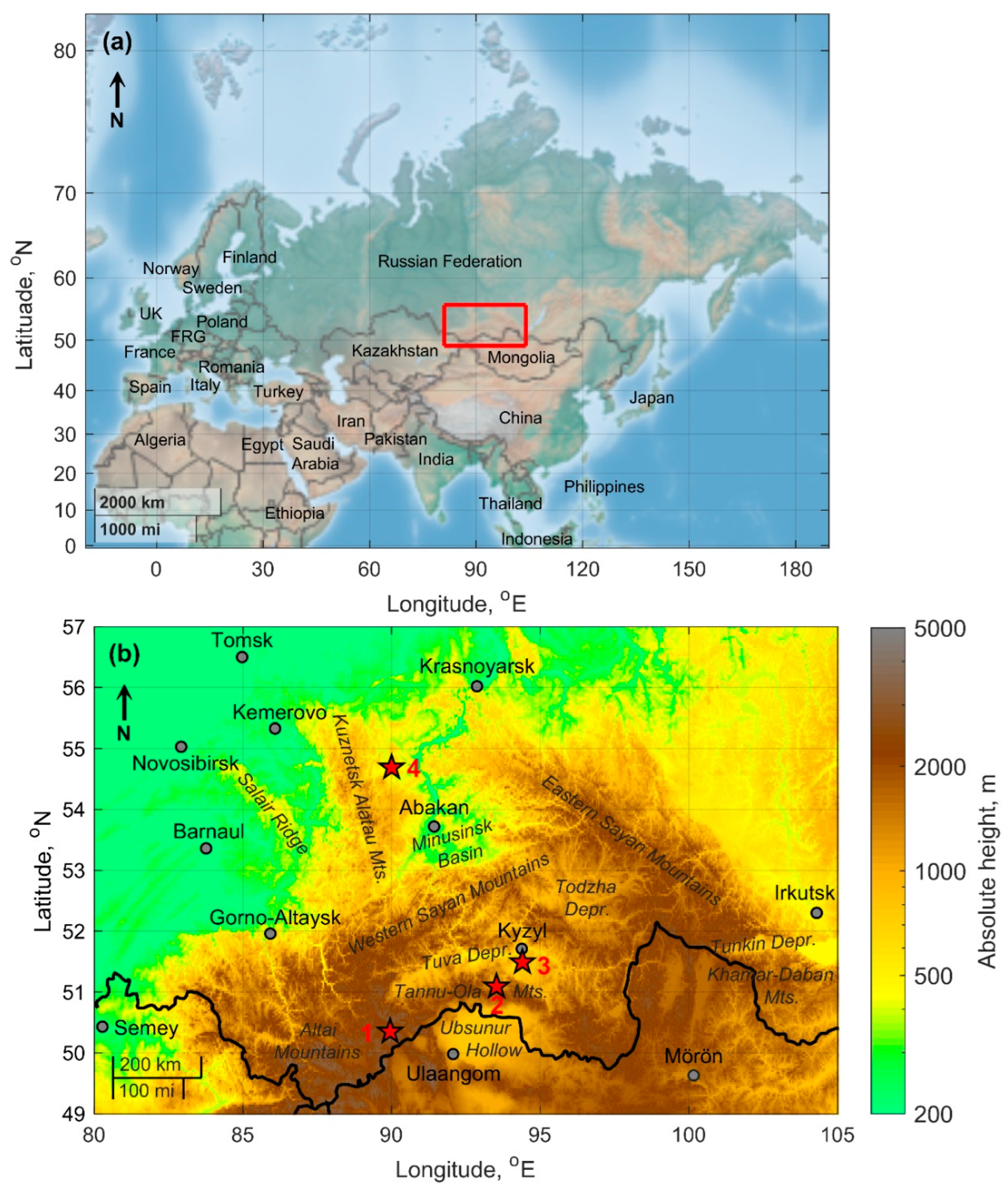
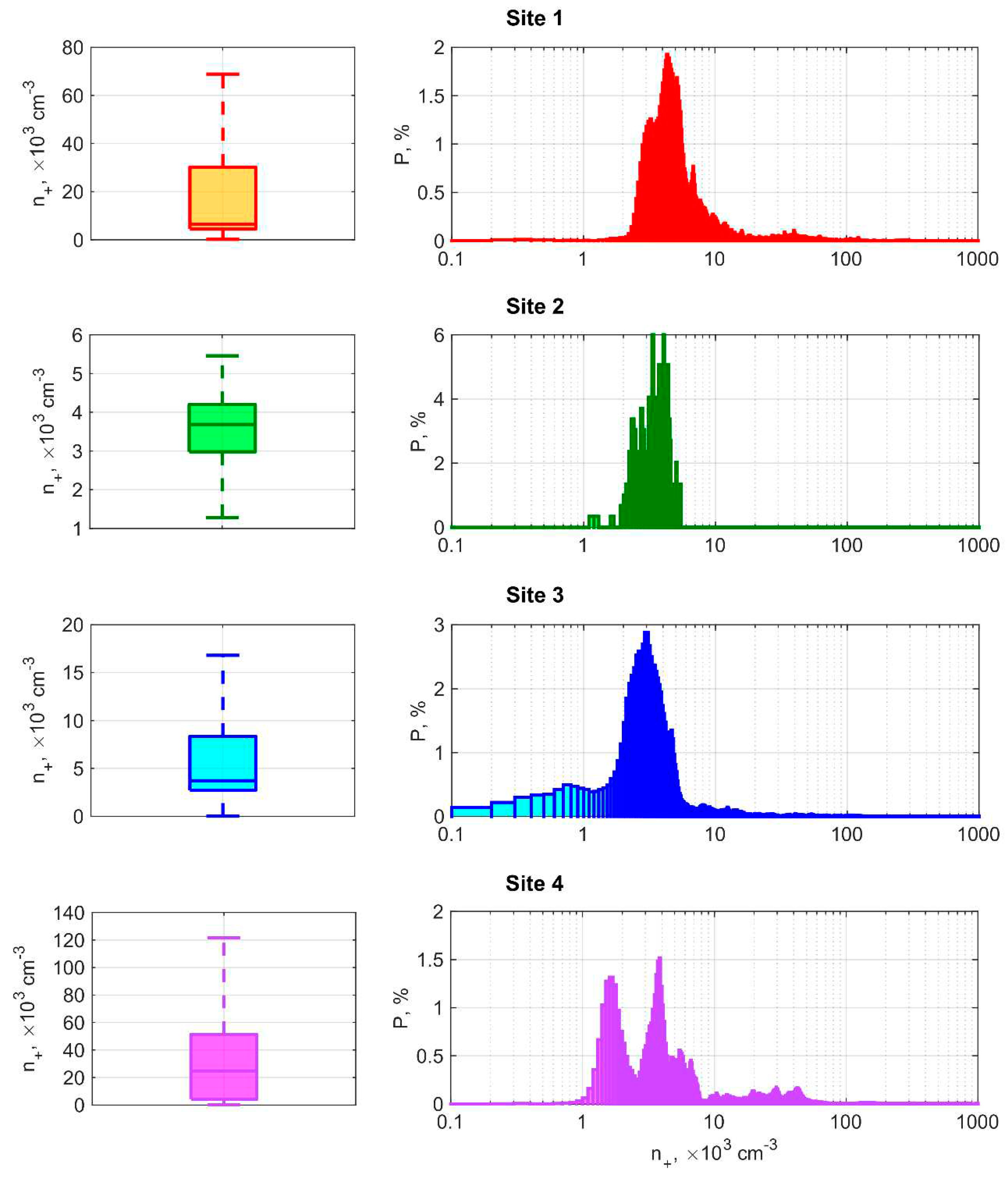
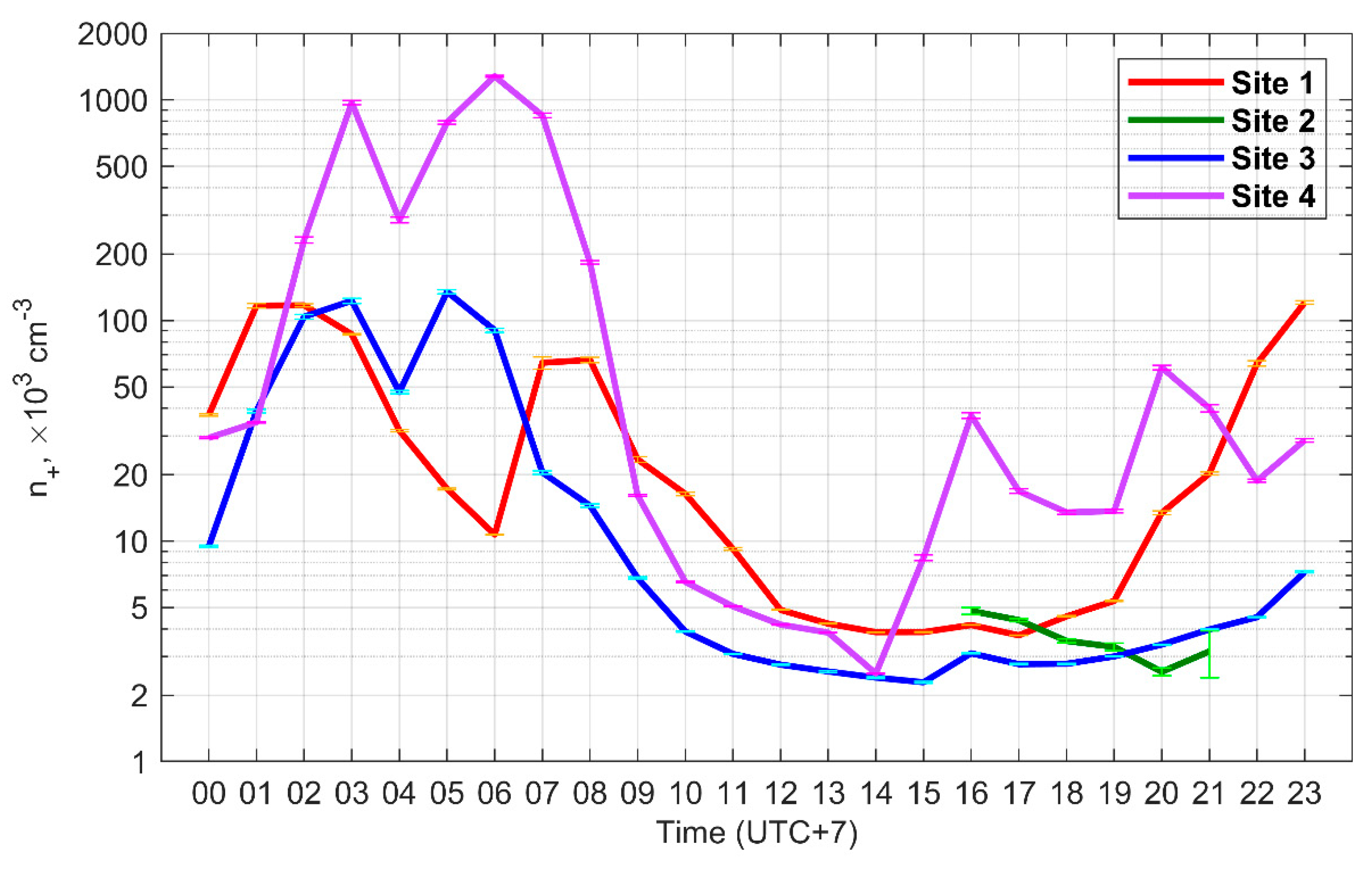
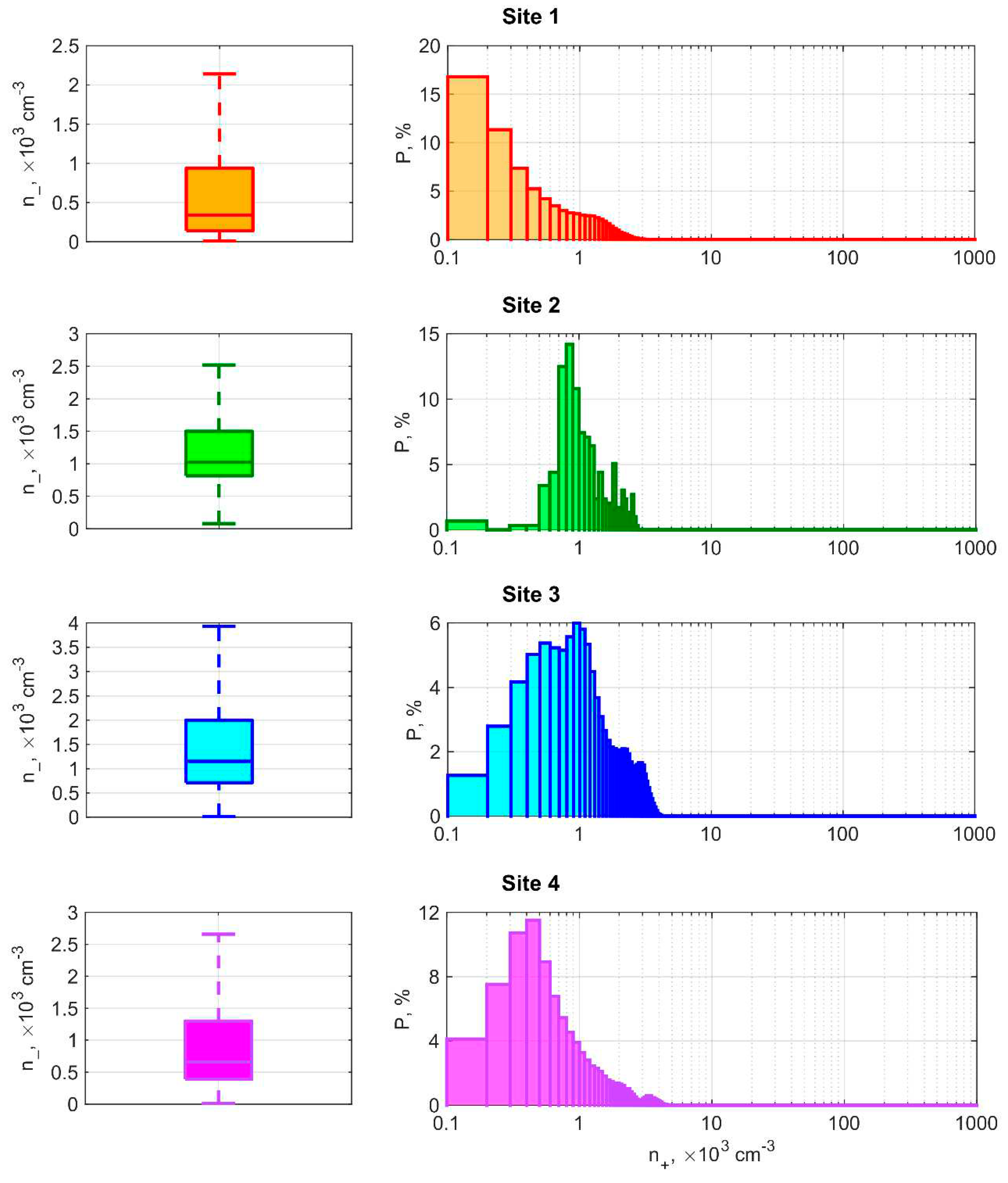
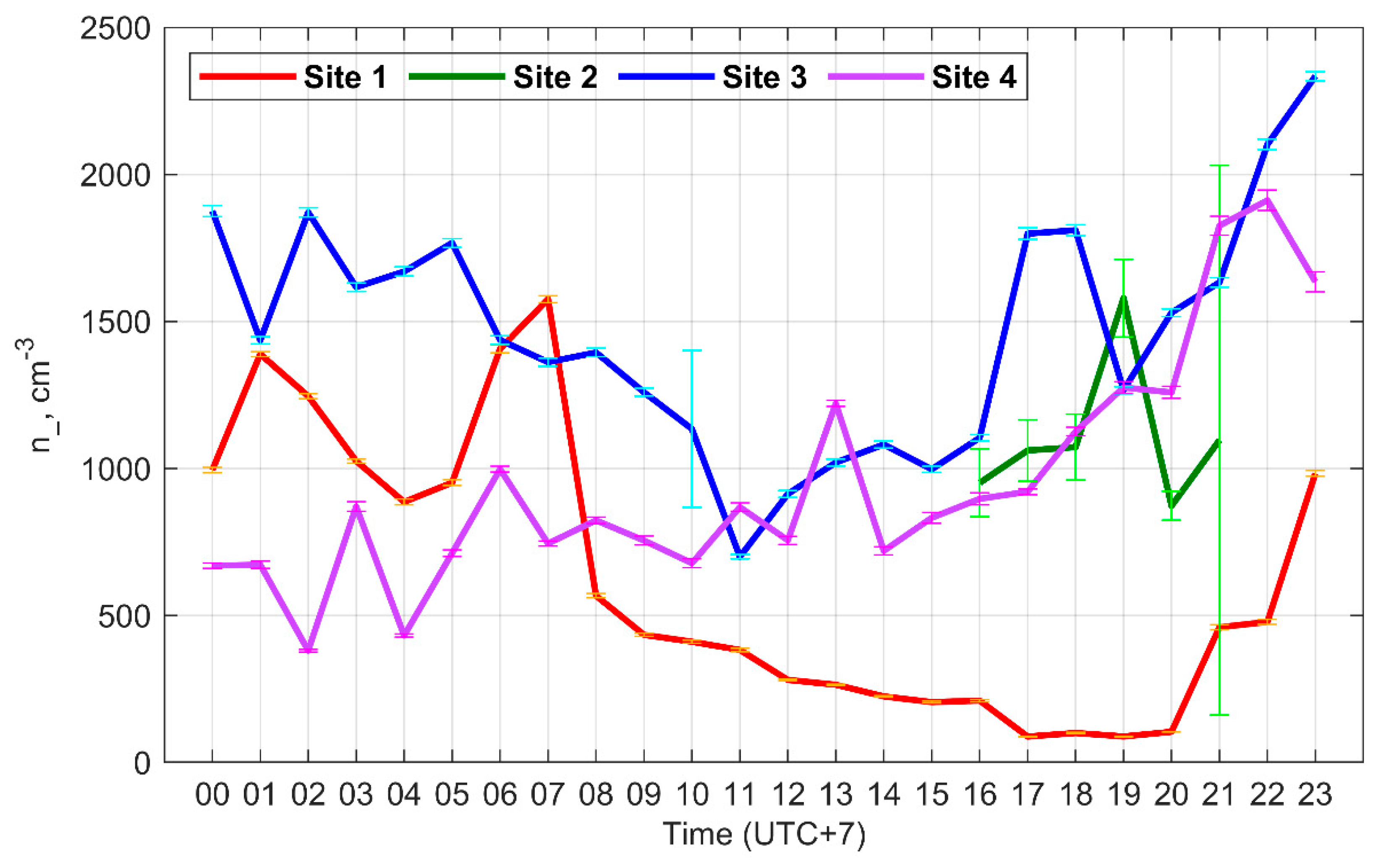
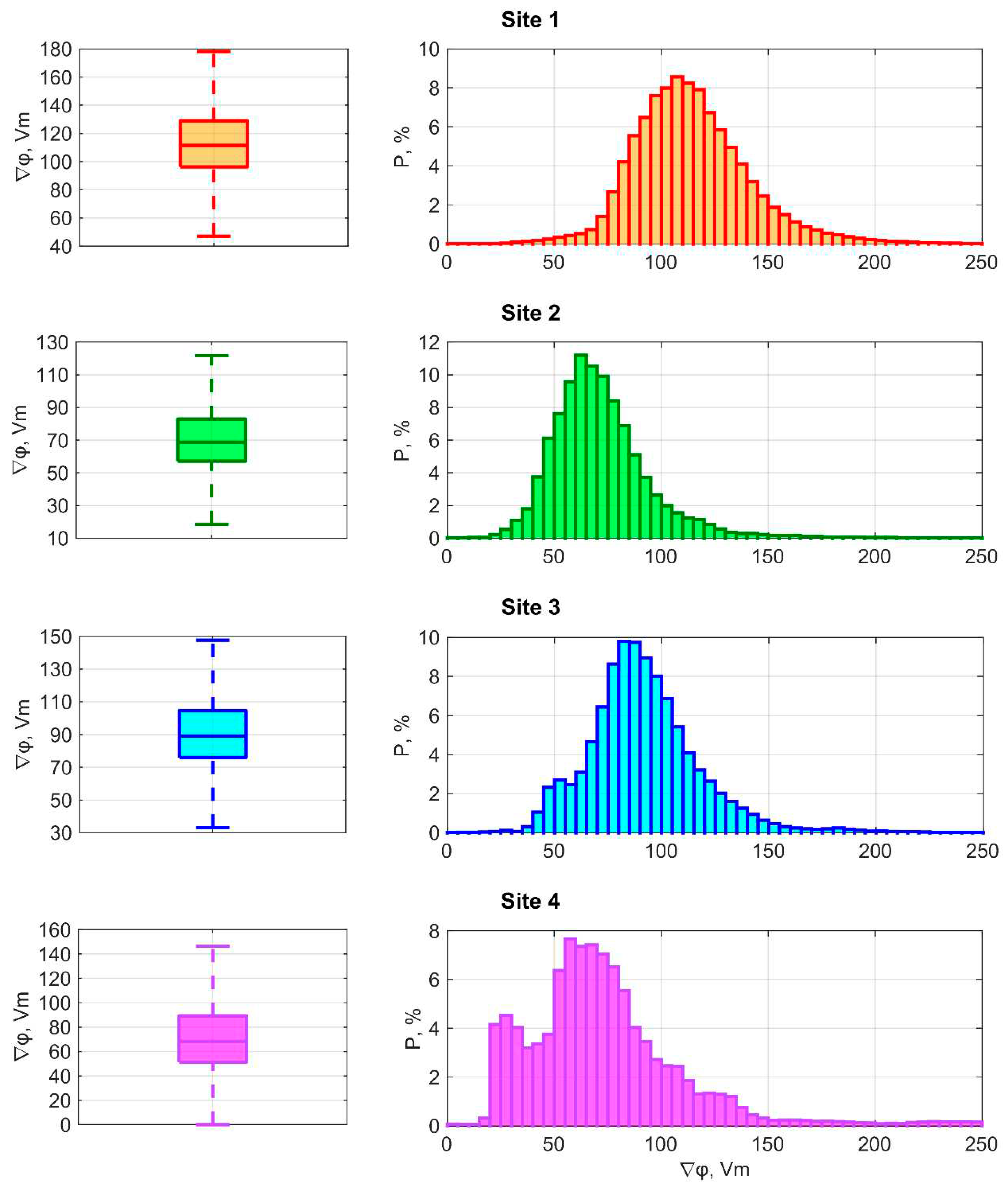
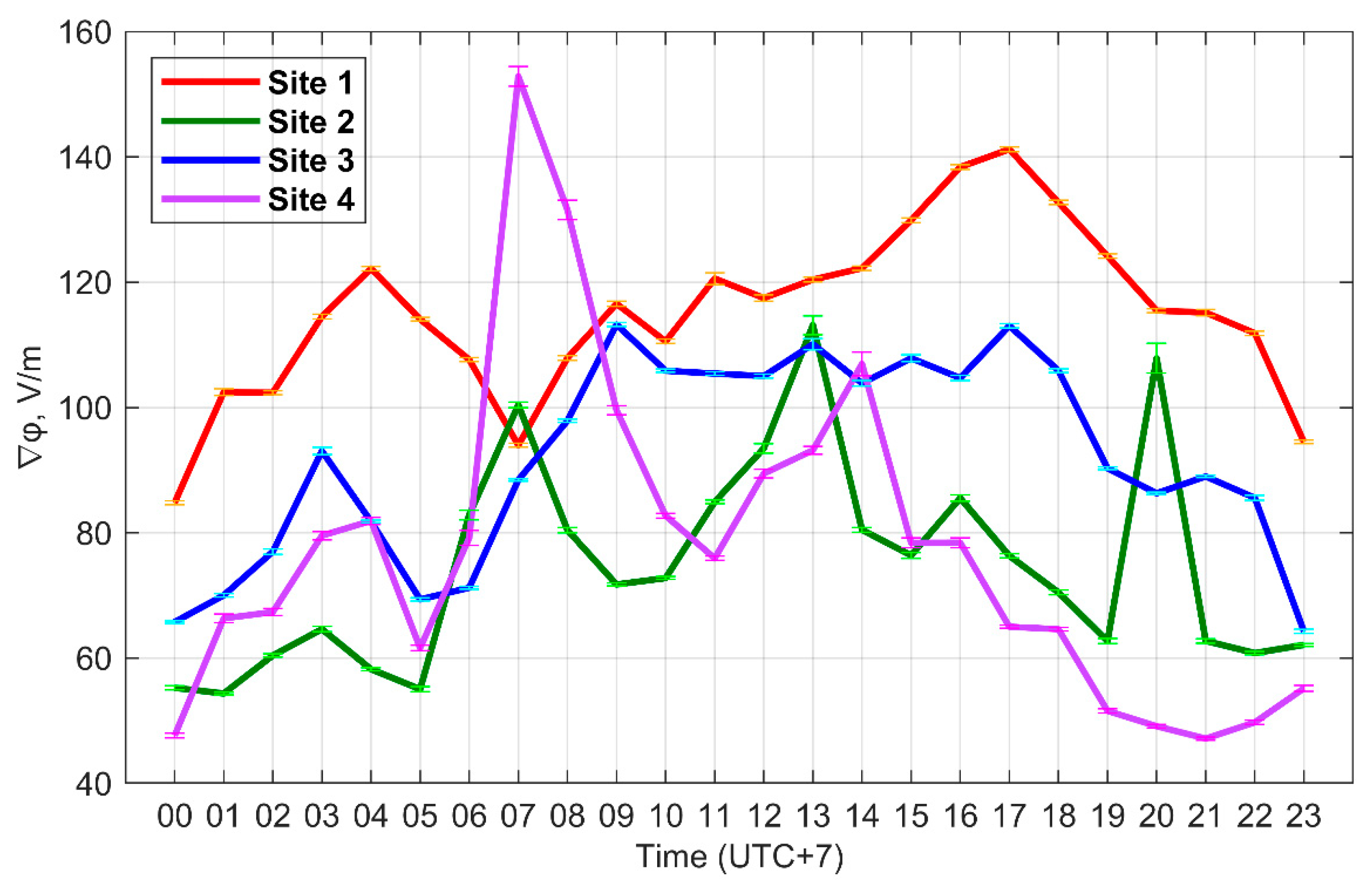
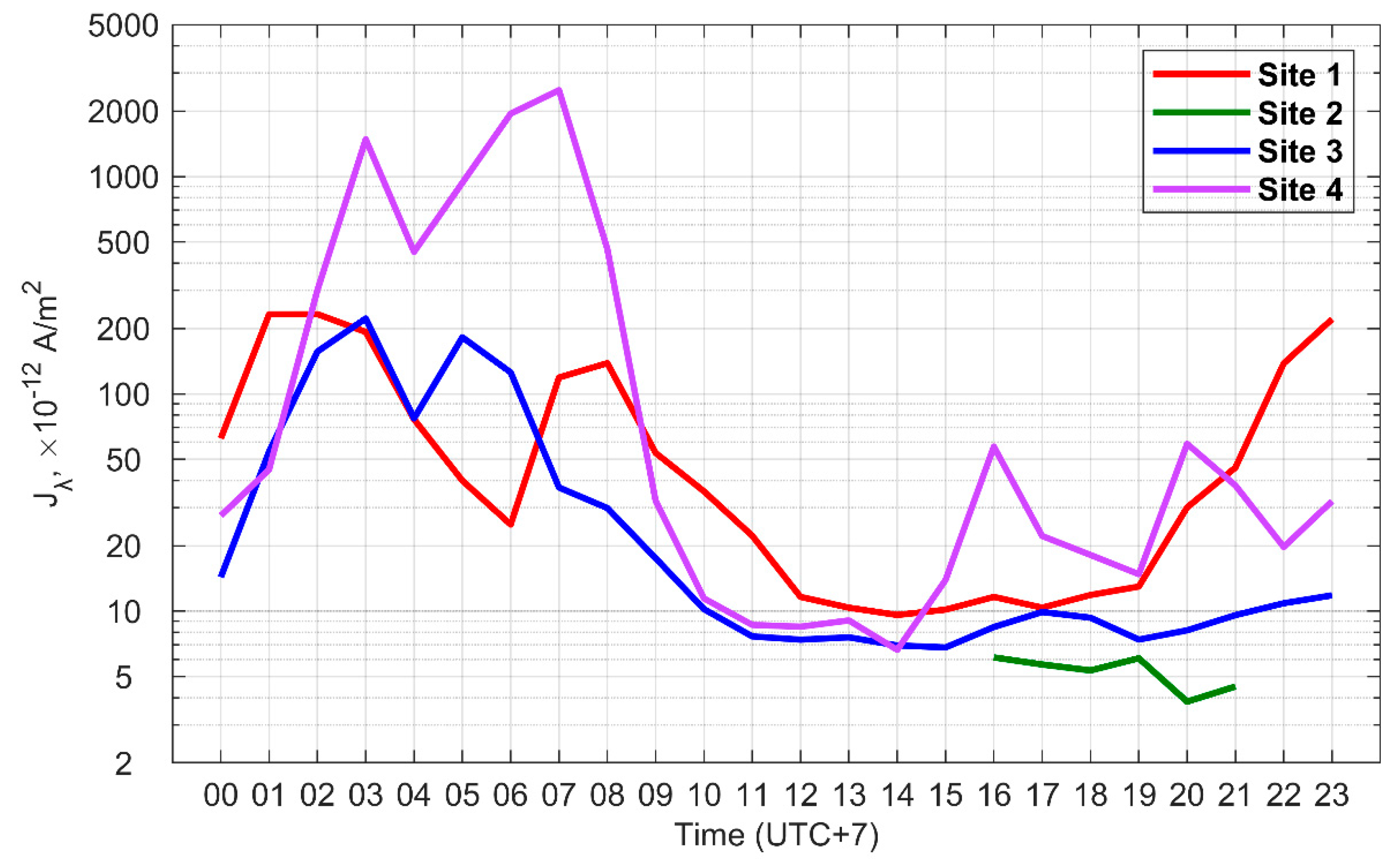
| Site number | Observation area | Lat., °N | Long., °E | Alt. a.s.l., m | Observation period |
|---|---|---|---|---|---|
| 1 | Plateau near the Mongun-Taiga mountain massif and Khindiktig-Khol lake | 50.4 | 90.0 | 2490 | 24–29.07.2022 |
| 2 | Bayan-Tala tract in the foothills of the Tannu-Ola ridge | 51.1 | 93.5 | 1030 | 19–22.07.2022 |
| 3 | Shol tract in the center of the Tyva depression | 51.5 | 94.4 | 910 | 01–06.08.2022 |
| 4 | Krasnaya Sopka tract between Belyo and Tus salt lakes in the Khakass-Minusinsk basin | 54.7 | 90.0 | 540 | 11–14.08.2022 |
Disclaimer/Publisher’s Note: The statements, opinions and data contained in all publications are solely those of the individual author(s) and contributor(s) and not of MDPI and/or the editor(s). MDPI and/or the editor(s) disclaim responsibility for any injury to people or property resulting from any ideas, methods, instructions or products referred to in the content. |
© 2023 by the authors. Licensee MDPI, Basel, Switzerland. This article is an open access article distributed under the terms and conditions of the Creative Commons Attribution (CC BY) license (http://creativecommons.org/licenses/by/4.0/).





